|

|
|
AGENDA
Strategy and Operations Committee Meeting
|
|
I hereby give notice that a Meeting of the Strategy and Operations Committee will be held on:
|
|
Date:
|
Thursday, 9 June 2022
|
|
Time:
|
9.30am
|
|
Location:
|
Council
Chamber
Ground
Floor, 175 Rimu Road
Paraparaumu
|
|
Glen O’Connor
Acting Group Manager Infrastructure Services
|
|
Strategy and
Operations Committee Meeting Agenda
|
9 June 2022
|
Kapiti Coast District Council
Notice is hereby given
that a meeting of the Strategy and
Operations Committee will be held
in the Council Chamber, Ground
Floor, 175 Rimu Road, Paraparaumu, on Thursday 9 June 2022, 9.30am.
Strategy and
Operations Committee Members
|
Cr
James Cootes
|
Chair
|
|
Cr
Gwynn Compton
|
Deputy
|
|
Mayor
K Gurunathan
|
Member
|
|
Deputy
Mayor Janet Holborow
|
Member
|
|
Cr
Angela Buswell
|
Member
|
|
Cr
Jackie Elliott
|
Member
|
|
Cr
Martin Halliday
|
Member
|
|
Cr
Sophie Handford
|
Member
|
|
Cr
Jocelyn Prvanov
|
Member
|
|
Cr
Bernie Randall
|
Member
|
|
Cr
Robert McCann
|
Member
|
2 Council
Blessing
“As we deliberate on the
issues before us, we trust that we will reflect positively on the
communities we serve. Let us all seek to be effective and just, so that with
courage, vision and energy, we provide positive leadership in a spirit of
harmony and compassion.”
I a mātou e whiriwhiri ana
i ngā take kei mua i ō mātou aroaro, e pono ana mātou ka
kaha tonu ki te whakapau mahara huapai mō ngā hapori e mahi nei
mātou. Me kaha hoki mātou katoa kia whaihua, kia tōtika
tā mātou mahi, ā, mā te māia, te tiro whakamua me te
hihiri ka taea te arahi i roto i te kotahitanga me te aroha.
3 Apologies
4 Declarations
of Interest Relating to Items on the Agenda
Notification from Elected
Members of:
4.1 – any interests that
may create a conflict with their role as an elected member relating to the
items of business for this meeting, and
4.2 – any interests in
items in which they have a direct or indirect pecuniary interest as provided
for in the Local Authorities (Members’ Interests) Act 1968
5 Public
Speaking Time for Items Relating to the Agenda
6 Members’
Business
(a)
Public Speaking Time Responses
(b)
Leave of Absence
(c)
Matters of an Urgent Nature (advice to be provided to the Chair prior to
the commencement of the meeting)
7 Updates
Nil
8 Reports
8.1 Climate
Emergency Action Report
Kaituhi |
Author: Brandy
Griffin, Principal Policy Advisor - Climate Change
Kaiwhakamana
| Authoriser: Glen O'Connor, Acting Group Manager
Infrastructure Services
Te pūtake |
Purpose
1 This
report seeks the Strategy and Operations Committee’s adoption of the
special report entitled Climate Emergency Action: Delivering on our climate
change commitments, attached as Appendix 1.
He
whakarāpopoto | Executive summary
2 An
executive summary is not required.
Te tuku haepapa
| Delegation
3 The
Strategy and Operations Committee has the delegation to adopt this special
report, as per the Governance Structure and Delegations for the 2019-2022
Triennium.
Taunakitanga | RECOMMENDATIONS
A. That
the Strategy and Operations Committee:
A.1 adopt
the special report entitled Climate Emergency Action: Delivering on our
climate change commitments, attached as Appendix 1.
A.2 In
the instance that any further changes are requested to the report, nominate
Councillor Sophie Handford, Mayor Gurunathan, and Acting Chief Executive Sean
Mallon to approve those changes.
A.3 Note
the intention of the communications team to develop an information campaign to
socialise the content of the report.
Tūāpapa | Background
4 On
29 July 2021, Council passed three resolutions to:
4.1 adopt
the Kāpiti Coast District Council Climate Emergency Action Framework,
4.2 request
the development of a climate change update report, to be presented back for adoption
before the end of this financial year, and
4.3 agree
that the climate change update report be annual.
5 This
special report, attached as Appendix 1, is delivering on the request for a
climate change update report to be presented back for adoption before the end
of this financial year.
He
kōrerorero | Discussion
6 Since
Kāpiti Coast District Council declared a climate change emergency in 2019
and adopted the Climate Emergency Action Framework in 2021, a significant
amount of work has taken place to ensure that climate change action is embedded
into Council activities.
7 To
provide a summary of Council’s current climate change actions, this
report:
7.1 summarises
the climate actions agreed for the first three years of the Long-term Plan 2021–41
(LTP),
7.2 highlights
special projects that are currently in process or planned within the first
three years of the LTP, and
7.3 reports
on recently completed climate actions.
8 The
vision at the heart of Council’s Climate Emergency Action Framework is a
thriving, vibrant and strong Kāpiti that has reduced its carbon footprint
significantly, transitioned to a low-carbon future, and prepared for challenges
and opportunities that come from responding to the climate crisis.
9 Working
towards each part of the vision provides a structure to Council’s climate
emergency action plan. When the report summarises the climate actions agreed
for the first three years of the LTP, the actions are categorised under climate
change mitigation, adaptation, or transition to show how they directly support
each part of the vision (with an acknowledgement that there are some
crossovers).
He
take | Issues
10 There
are no issues in relation to this report.
Ngā
kōwhiringa | Options
11 There
are no options in relation to this report.
Tangata whenua
12 This
report summarises actions that were agreed through Council’s current LTP.
Engagement with iwi did not occur during the development of this report, but
rather through the LTP engagement process. Engagement will continue to
occur on a project-by-project basis.
Panonitanga āhuarangi | Climate change
13 Acting
on climate change was a key strategic driver in the LTP. Feedback from our iwi
partners and the community confirmed ongoing support for a range of climate
change actions, including corporate and districtwide emissions reduction and
waste minimisation programmes as well as improvements to support the
sustainability and resilience of our environment, assets, and communities.
14 This
report summarises the climate change actions that are currently planned, as
well as those that have been completed recently.
Ahumoni me ngā rawa | Financial
and resourcing
15 There
are no financial considerations for this report.
Ture me ngā Tūraru | Legal
and risk
16 There
are no legal considerations for this report.
Ngā pānga ki ngā kaupapa here | Policy impact
17 There
are no policy considerations for this report.
Te whakawhiti
kōrero me te tūhono | Communications & engagement
18 With
support from the communications team, an initial communications approach has
been discussed.
Te mahere tūhono | Engagement
planning
19 Following
the adoption of this report, Council officers will engage a designer and look
to socialise the report with the community via established communications
channels.
Whakatairanga |
Publicity
20 Council officers will work to publicise this information
using a variety of communication channels, as discussed above.
Ngā āpitihanga | Attachments
1. Draft
Special Report on Climate Emergency Action ⇩ 
|
Strategy and
Operations Committee Meeting Agenda
|
9 June 2022
|





























































8.2 Council
performance for quarter three ended 31 March 2022
Kaituhi |
Author: Jo
Bryan, Manager Corporate Planning and Reporting
Kaiwhakamana
| Authoriser: Mark de Haast, Group Manager Corporate Services
Te pūtake |
Purpose
1 The
Council Performance Report for quarter three (ended 31 March 2022) provides an
overview of financial and non-financial performance against the 2021-41
Long-term Plan (LTP).
He
whakarāpopoto | Executive summary
2 An
executive summary is not required for this report.
Te tuku haepapa
| Delegation
The Strategy and Operations Committee has delegated
authority to consider this under section B.1. of the 2019-2022 Triennium
Governance Structure and Delegations including ‘overviewing strategic
programmes’ and ‘financial management.’
Taunakitanga | RECOMMENDATIONS
It is
recommended that the Strategy and Operations Committee:
A. receives
this Council Performance Report (Appendix 1)
B. notes
the Council’s performance for the quarter ended 31 March 2022.
Tūāpapa | Background
4 The
previous Council Performance Report for the half year ending 31 December 2021,
was the first report in this new format, combining three previously separate
reports (the Activity Report, the Finance Report, and the Residents Opinion
Survey results) into one report
He
kōrerorero | Discussion
He
take | Issues
Performance measure progress
5 In
quarter three, the Council achieved 47 percent of performance measures. Up to
20 percent of performance measures have not yet
met target and 33 percent are annual measures that are only for the Annual
Report. More information is in Appendix 1.
Project delivery
6 For
Council’s projects and initiatives, 80 percent are on track, 12.5 percent
are off track, 2.5 percent have not yet started, and 5 percent are completed.
More information is in Appendix 1.
Financial management
7 Council
achieved an $8.2 million net surplus (revenue less expenditure) for the nine months to 31 March 2022. The surplus
came mainly from external grants and subsidies received to part-fund the
Council’s capital works programme, and development contributions. This
does not represent a permanent cash surplus for the Council. The
Council’s net worth as of 31 March 2022 is $1.8 billion, mainly
represented by infrastructure assets.
8 The
Council has spent $29.4 million (40 percent) of its capital works programme
(full-year budget of $73 million) as of 31 March 2022. At the time of writing
this report, the forecast full year spend is estimated to be approximately $50
million but may be subject to further change as the year continues.
9 Net
debt as of 31 March 2022 was $168 million, equating to 175 percent of total
operating revenue, well below the Councils LTP upper limit of 280 percent. More
information is in Appendix 1.
Residents’ satisfaction
10 The
residents’ overall satisfaction score for the third quarter was 71 percent. This was a 1 percent decrease from quarter
two but a 1 percent increase from the same time last year. Residents’
overall satisfaction with Council services outperformed national satisfaction
results (across other councils) for the last three quarters.
11 Satisfaction
with value for money improved, from 47 percent in quarter two, to 53 percent in
quarter three.
12 Residents’
responses indicate that the Council is making good progress on three of its
four outcomes, with the housing remaining a challenge that will take time to
shift with current and planned initiatives. More information is in Appendix 1
Ngā
kōwhiringa | Options
13 There
are no options to consider with this report.
Tangata whenua
14 There
are no tangata whenua matters in addition to those
already outlined in this report.
Panonitanga āhuarangi | Climate change
15 There
are no climate change matters in addition to those already outlined in this
report.
Ahumoni me ngā rawa | Financial
and resourcing
16 There
are no financial and resourcing matters in addition to those outlined in this
report.
Ture me ngā Tūraru | Legal
and risk
There
are no legal and risk matters in addition to those already outlined in this
report.Ngā pānga ki ngā kaupapa here
| Policy
impact
18 There
are no policy impacts arising directly from this report.
Te whakawhiti
kōrero me te tūhono | Communications & engagement
Te mahere tūhono | Engagement
planning
19 There
is no engagement planning required for this report
Whakatairanga |
Publicity
20 The
Council Performance Report will be made publicly available on the
Council’s website.
Ngā āpitihanga | Attachments
1. Council
Performance Review ⇩ 
|
Strategy and
Operations Committee Meeting Agenda
|
9 June 2022
|










































































8.3 Six
Month Update - Economic Development Kotahitanga Board
Kaituhi |
Author: Eva
George, Economic Development Advisor
Kaiwhakamana
| Authoriser: Angela Bell, Strategy Manager
Te pūtake |
Purpose
1 This
report provides a six-month update from the Chair of the Economic Development
Kotahitanga Board on the Kāpiti Coast Economic Development Strategy and
Implementation Plan 2020-23.
He
whakarāpopoto | Executive summary
2 This
paper will provide a summary of the impact of the Economic Development
Kotahitanga Board work programme on the Kāpiti Coast economy over the past
6 months and seek reappointment of the independent Chair.
Te tuku haepapa
| Delegation
3 The Strategy
and Operations Committee has delegated authority to consider this report and to
appoint the Independent Chair of the Economic Development Kotahitanga Board
under section B.1 of the 2019-2022 Triennium Governance Structure and
Delegations, “Economic Development Strategy”.
Taunakitanga | RECOMMENDATIONS
A. That
the Strategy and Operations Committee notes the 6-monthly update from the Economic
Development Kotahitanga Board Independent Chair, Neil Mackay.
B. That
the Strategy and Operations Committee re-appoints Neil Mackay as the Economic
Development Kotahitanga Board Independent Chair, for a further 12-month period
from July 2022.
Tūāpapa | Background
4 In
July 2020, Council approved the Kāpiti Coast Economic Development Strategy
and Implementation Plan 2020-23 (Strategy). This included approval to establish
the Economic Development Kotahitanga Board (EDKB), with six monthly updates to
be provided to the Strategy and Operations Committee (Committee). The Terms of
Reference for the EDKB were approved as part of the Strategy. This is the third
update provided to the Committee.
He kōrerorero | Discussion
Six-Monthly
Reporting
5 The delivery
of the Economic Development Strategy and Implementation Plan is fundamental to
the advancement of the Community Outcomes set out in the Kāpiti Coast
District Council’s Long-Term Plan 2021-41, in particular that “Our
local economy is prosperous with ample opportunities for people to work and
learn in Kāpiti.
6 In
accordance with the EDKB Terms of Reference, a six-month report from Neil
Mackay, Independent Chair EDKB is attached in appendix one. The report outlines
that the strategy and its implementation plan remain on track for delivery and
explains progress against the core responsibilities and priorities of the
Board. A May status update for the Economic Development Strategy and
Implementation Plan 2020-2023 is also attached as Appendix 2 for your
information.
7 In
order to monitor progress, the following table was developed to enable the
ongoing measurement of impacts outlined in the Strategy. The results are
sourced from annual Regional Economic Profile undertaken by Infometrics. Where
available, interim results will also be recorded pending the availability of
final indicators. The latest data provided by Infometrics was released March
2022 and reflects the 12-month period to 31 March 2021.
Table
1: Kāpiti Coast EDS measurement of impacts
8 Table
1 shows an increase in the number of filled jobs, however the unemployment rate
increased to 3.9% as at 30 March 2021. The latest quarterly report by
Infometrics, for the quarter ending March 2022, shows the current unemployment
rate has since decreased to 2.6%. Additionally, the NEET (Young people not in
employment, education or training) rate decreased by 2.7% in the 12 months to
March 2021.
9 There
are both positive and negative sides to this, the data confirms that there is a
lot of opportunity for people seeking employment in the local economy and that
the number of people in employment locally is increasing. On the other hand, it
also shows a very tight job market, which often means that is difficult for
businesses to recruit the workforce they need locally. This directly aligns
with the work that the EDKB is leading, e.g. the Workforce Plan and the
Education Hub, which are targeting unique opportunities to improve capacity in
the local labour market (semi-retired people and NEETs to name a few).
10 The
data in Table 1 also shows an increase in income levels: mean income has
increased by 3.5% compared to 2.6% nationally. In addition, GDP per filled job
has risen by 0.9% where there is a decrease in numbers at a national level. The
data suggests that not only are more people being employed in the district, we
are also seeing more higher value employment opportunities locally.
11 Although
the opening of Transmission Gully on March 31st was too late to
affect the numbers in the March 2022 quarter, expectations of greater
connectivity to the rest of Wellington region may already be boosting economic
indicators.
Board Appointments
12 The
current EDKB membership is as follows:
· Independent
Chair: Neil MacKay
· Ngāti
Raukawa ki te Tonga Rep: Kim Tahiwi
· Ngāti Toa Rangatira Rep: New representative to be appointed.
· Te
Ati Awa ki Whakarongotai Rep: Russell Spratt
· Independent
Member: Hillmare Shultz
· Independent
Member: Scott Houston
· Independent
Member: Chris Claridge
· Council
ex-officio representative: Cr Angela Buswell.
13 The
Board currently has one vacancy following the recent resignation of Herani
Demuth, due to competing priorities and is awaiting the appointment of a new
representative for Ngāti Toa Rangatira. The
appointment of an iwi representative is undertaken directly by iwi, which is
then confirmed with the EDKB Chair.
14 The
appointment of the current EDKB independent Chair (Neil Mackay) expires at the
end of June 2022. This appointment is made by the Strategy & Operations Committee
He
take | Issues
15 The
current EDKB Chair, Neil Mackay was reappointed for a further 12-month period
from July 2021 by this committee. During this 12-month period, strong progress
has continued to be maintained in the implementation of the
strategy.
16 The
EDKB has effectively been operating for a 18 month period and as outlined in
the Chair’s report, is performing well against its core responsibilities
and priorities.
17 On
the basis of the performance to date, it is recommended that Neil
MacKay’s appointment is extended for a further 12-month period as the
Independent Chair of the EDKB. This recommendation is based on the performance
of the board during the current period and to provide continuity to the EDKB as
it continues to strengthen relationships with key partners and stakeholders and
delivers a number of key actions in the strategy.
Ngā
kōwhiringa | Options
18 Officers
recommend that Neil MacKay is reappointed as Independent Chair of the
EDKB. If the Committee does not wish to reappoint Mr MacKay to this
position, further options and advice would be provided to the Committee to
support the appointment of another suitable Chair.
Tangata whenua
19 Appointments
to the EDKB include representation of each of Council’s three iwi
partners.
20 The
EDKB is currently working a number of projects that have significant
involvement from our iwi partners.
Panonitanga āhuarangi | Climate change
21 Council
adopted the Climate Emergency Action Framework in July 2021. Its vision is
‘a thriving, vibrant and strong Kāpiti that has reduced its carbon
footprint significantly, transitioned to a low-carbon future, and prepared for
challenges and opportunities that come from responding to the climate
crisis’.
22 Research
and experience are showing that consumers are more and more looking to support
businesses that are sustainable. This is visible both in New Zealand and
overseas (our future customers). This is true also for the workforce.
“Making your company an organisation that does good in the
world—rather than just a place that provides a paycheck — can be a
competitive advantage when attracting the best talent”[1].
23 The
Economic Development (ED) Team is working together with teams across Council in
supporting local businesses to work in environmentally conscious ways. The Team
has hosted a sustainable business network meeting in February and is engaging
with businesses that want to further support and develop the concept of a
network for the Coast: Pakihi Toitū o Kāpiti – Sustainable
Businesses.
Ahumoni me ngā rawa | Financial
and resourcing
24 There are no financial or
resourcing considerations for this report.
Ture me ngā Tūraru | Legal
and risk
25 There are no legal and risk
considerations for this report.
Ngā pānga ki ngā kaupapa here | Policy impact
26 This
report has been considered against the Kāpiti Coast Economic Development
Strategy and Implementation Plan 2020 – 23.
Te whakawhiti
kōrero me te tūhono | Communications & engagement
Te mahere tūhono | Engagement
planning
27 An engagement plan is not
needed to implement this decision
Whakatairanga |
Publicity
28 The Economic Development
Team will continue to work proactively with the EDKB and the Council
Communications Team to proactively promote the work being undertaken to
implement the economic development strategy.
Ngā āpitihanga | Attachments
1. EDKB
6 monthly report to May 2022 ⇩ 
2. ED
Strategy Actions Status Table - May 22 ⇩ 
|
Strategy and
Operations Committee Meeting Agenda
|
9 June 2022
|






|
Strategy and Operations Committee Meeting
Agenda
|
9 June 2022
|




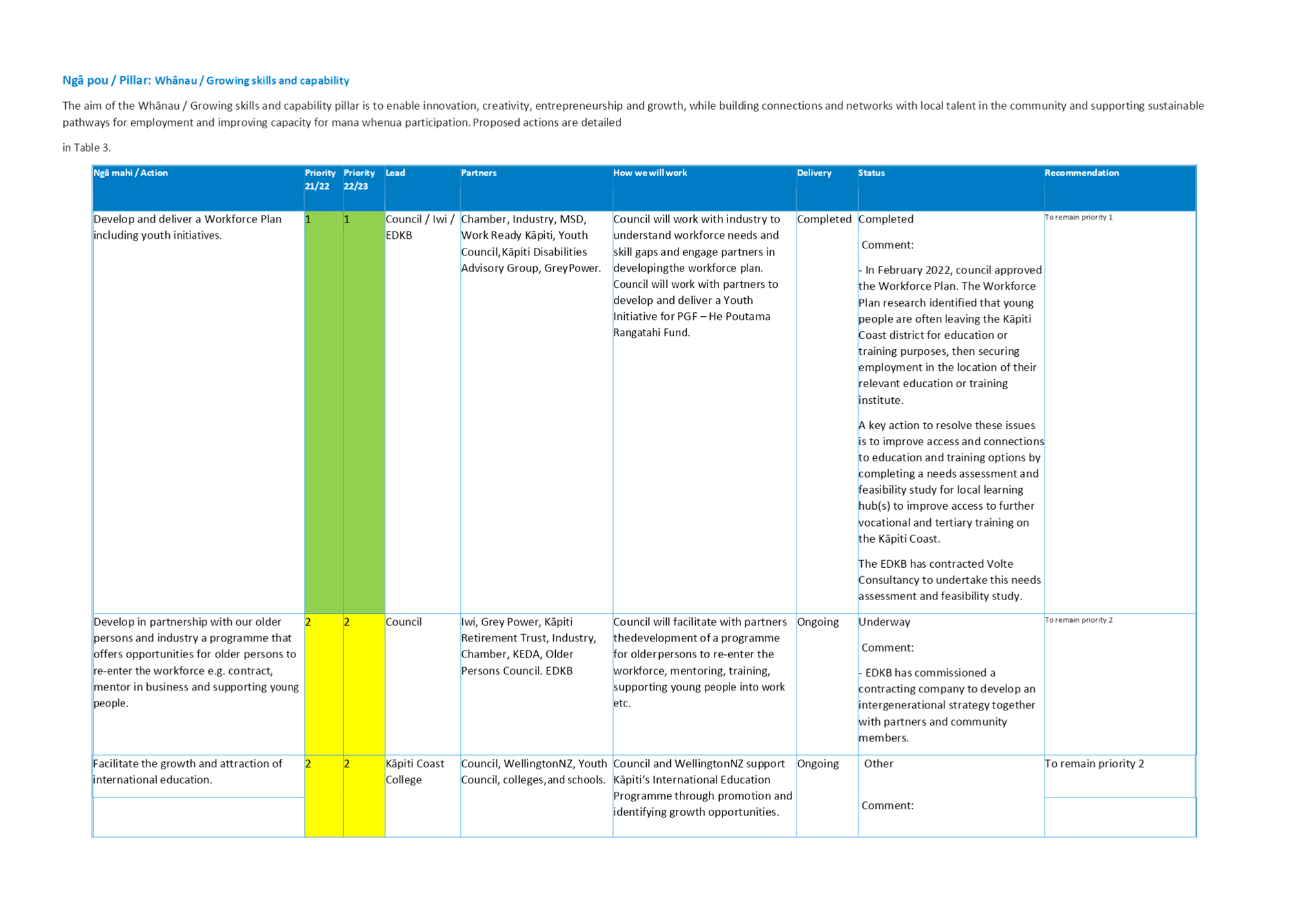





8.4 An
Overview of Social Investment Funded Projects 2018-2021
Kaituhi |
Author: Emma
Haxton, Contractor to Kāpiti Coast District Council
Kaiwhakamana
| Authoriser: Janice McDougall, Group Manager People and
Partnerships
Te pūtake |
Purpose
This paper, and accompanying
video, provide an overview of the eight projects delivered by not-for-profit
community organisations under the first round of the Social Investment Fund
from 2018/19.
He
whakarāpopoto | Executive summary
Te tuku haepapa
| Delegation
The Strategy and Operations Committee
has delegated authority to consider this matter under section B.1 of the
2019-2022 Triennium Governance Structure. ®
Taunakitanga | RECOMMENDATIONS
A. that the Strategy and
Operations Committee receives this report and accompanying video providing an
overview of the eight projects delivered by not-for-profit community
organisations under the first round of the Social Investment Fund from 2018/19;
B. that the Strategy and
Operations Committee formally acknowledges the contributions made to the
district by these organisations, recognising in particular the additional
challenges they faced due to the global pandemic.
Tūāpapa | Background
2 The
first round of the Social Investment Fund contributed to outcomes of the Long
term Plan 2018 and Council’s promotion of social and cultural wellbeing
in Kāpiti
3 The
Social Investment Fund is an outcome focused contestable funding model which
ensures funding is aligned with Council’s community outcomes. In December
2017, Council approved the priorities and principles of the Social Investment
Fund.
4 Funding
is allocated to organisations that support the following social investment
priorities:
· Connected
Communities
· Safe Communities
· Capable Sector
5 The
Connected Communities priority supports activities that build the capacity for
our communities to maximise their strengths, address local needs and enhance
wellbeing.
6 The
Capable Sector priority focused on capacity-building support to assist
organisations to build their resilience, sustainability and effectiveness. The
realisation of outcomes of the Capable Sector priority are long term.
7 The
Safe Communities priority supports strategic partnerships and the development
of a district-wide strategic plan for community safety and crime prevention.
8 Information
about the Social Investment priorities, principles and outcomes sought can be
found at Appendix One.
He
kōrerorero | Discussion
9 In
2018, a robust decision-making process resulted in eight projects being awarded
funding for a range of community initiatives through the Social Investment
Fund. Contracts were put in place from 1 July 2018 for 3-year
periods
10 Eight
projects were funded through Social Investment Fund 2018/19-2020/21:
● Age
Concern Kāpiti: Funding to deliver an action plan to address social
isolation for older people
● Energise
Ōtaki: Funding for the organisational capacity and capability
development of Energise Ōtaki while they continue to grow their
community-led initiatives
● Kāpiti
Impact Trust: Funding for an early intervention strength based mentoring
programme for 9 - 13 year olds.
● Kāpiti
Women’s Centre and Kāpiti Living Without Violence: Funding
to provide a joint service to reduce family violence by working together
● Kapiti
Youth Support: Funding for the He Kākano mentoring programme for
at-risk young people
● Māoriland
Charitable Trust: Funding for a range of tikanga māori based,
rangatahi and community led activities
● Ngā
Hapu o Ōtaki: Funding for tikanga māori based, rangatahi led
activities to revitalise connection to marae.
● Volunteer
Kāpiti and Kāpiti Impact Trust: Funding for a strategic programme
to build the capability and capacity of our community and social sector.
11 The
table below provides a breakdown of the funding provided through the Social
Investment Fund to each project over the 3 years.
|
Funded organisations
|
Recommended funding:
Option One
|
|
|
Year 1
2018/19
|
Year 2
2019/20
|
Year 3
2020/21
|
Total
|
|
|
Age Concern Kāpiti
|
$45,000
|
$42,000
|
$42,000
|
$129,000
|
|
|
Energise Ōtaki
|
$40,000
|
$47,000
|
$47,000
|
$134,000
|
|
|
Kāpiti Impact Trust
|
$15,000
|
$20,000
|
$20,000
|
$55,000
|
|
Ngā Hapu o Ōtaki (Raukawa Marae Management Committee$30,000
$27,000
$27,000
$84,000
|
| Kāpiti Impact Trust
& Volunteer Kāpiti |
$65,000
|
$70,000
|
$70,000
|
$205,000
|
|
|
Kāpiti Women’s Centre
& Kāpiti Living Without Violence
|
$30,000
|
$30,000
|
$30,000
|
$90,000
|
|
|
Kapiti Youth Support
|
$50,000
|
$47,000
|
$47,000
|
$144,000
|
|
|
Māoriland Charitable Trust
|
$50,000
|
$47,000
|
$47,000
|
$144,000
|
|
|
Ngā Hapu o Ōtaki Raukawa Marae Management Committee
|
$30,000
|
$27,000
|
(withdrew)
|
$57,000
|
|
|
Total pool of fund
|
$325,000
|
$330,000
|
$330,000
|
$958,000
|
|
12 Most
of the projects delivered under the Social Investment Fund were not fully
funded by Council. Many organisations supplemented the funding received from
Council with funding from other sources to achieve project outcomes.
13 An
overview of the Social Investment Fund Projects 2018- 2021 can be found at
Appendix Two.
14 The
accompanying video provides a view from the organisations contracted to deliver
services. All organisations that received funding participated providing a
valuable perspective of what was achieved with the funding, and how it has
strengthened their ability to deliver into the future.
He
take | Issues
15 Overall
there is good evidence of progress in achieving the intended impacts of the
Social Investment Fund.
16 Two
of the projects contributed knowledge not previously researched at depth in
Kāpiti. Those were:
· the AgeConnect
Project delivered by Age Concern about social isolation experienced by older
people
· the Capable Sector
Project delivered by Kāpiti Impact Trust and Volunteer Kāpiti about
the Kāpiti social and community sector.
17 Several
organisations noted that the Social Investment Fund allowed them to invest in
long term resources and make significant progress in their work overall.
Organisations report that the long term nature of the funding:
· allowed them to
make a stronger impact on their project outcomes
· provided
credibility to their projects and, as a result, other funding agencies were
more receptive to providing support.
18 The
Covid 19 pandemic slowed the ability of some organisations to make progress on
contract deliverables as they focused on immediate community needs in the
pandemic. Not all of the organisations were able to complete the project
deliverables intended when they started out.
19 Each
organisation was offered the opportunity to repurpose some of their Social
Investment Funding from Council to support their Covid 19 response. Council
staff worked alongside several organisations to rework deliverables and put in
place contract extensions.
20 Organisations
commented that the work completed in Year One before the pandemic set them up
well to respond to the challenges the pandemic created. Many organisations were
able to adapt and expand their Social Investment funded activities
online.
Ngā
kōwhiringa | Options
Tangata whenua
21 The
Social Investment Fund and associated support for fund holders contributes to
Council’s obligations to Māori under the Treaty of Waitangi, Local
Government Act 2002 and other relevant legislation.
22 The
Social Investment Fund puts iwi prosperity and iwi aspirations at the fore, as
key principles for improving social outcomes that contribute to community
wellbeing. Advice sought from Te Whakaminenga o Kāpiti was sought in the
establishment of the Social Investment Fund.
23 The
funding model embeds an equity framework that reinforces the Tiriti principle
of Tino Rangatiratanga (iwi-led initiatives to achieve iwi aspirations) to
facilitate Māori whakairo (Māori thinking and understanding) to
enhance outcomes.
24 Several
projects were focused solely on Ōtaki and contributed to addressing
inequity with direct benefits for mana whenua. Other organisations had
deliverables to progress their commitment to Treaty of Waitangi in practice and
their contribution to supporting iwi aspirations. The Council provided training
opportunities and one to one mentoring to support community organisations with
their cultural competence and engagement with iwi as a part of the support
package under the Social Investment Fund.
Panonitanga āhuarangi | Climate change
25 A
key principle of the Social Investment Fund is:
Sustainability -
organisations and initiatives encourage innovation and work towards becoming
sustainable in all respects, including environmentally.
26 Two
of the funded projects had deliverables and outcomes related to climate change
and/ or environmental sustainability. These were Energise Ōtaki’s
project and Māoriland Charitable Trust’s project.
Ahumoni me ngā rawa | Financial
and resourcing
27 The
Social Investment Fund was $985,000 in total for the three year period 2018/19
– 2020/21 under the Community Support Activity.
Ture me ngā Tūraru | Legal
and risk
28 No
legal risks are identified at this time. Legal advice was sought in the
development of procurement processes and contract development.
Ngā pānga ki ngā kaupapa here | Policy impact
29 This
matter has a low level of significance under Council’s Significant and
Engagement Policy.
Te whakawhiti
kōrero me te tūhono | Communications & engagement
Te mahere tūhono | Engagement
planning
30 A
robust engagement approach was delivered which included forums, training
opportunities, one to one advice and flexible contract support. Active contract
management was undertaken by the Connected Communities team and included,
working with funded organisations on responding to Covid 19.
Whakatairanga |
Publicity
31 A
communications plan provides the framework for information to the wider
community about the Social Investment Fund. Decisions on the recommendation in
this report will be communicated as part of the ongoing Social Investment
programme communications activity.
Ngā āpitihanga | Attachments
1. Appendix
One Social Investment Priorities, Principles and Outcomes ⇩ 
2. Appendix
Two An Overview of Social Investment Funded Projects 2018-2021 ⇩ 
|
Strategy and
Operations Committee Meeting Agenda
|
9 June 2022
|

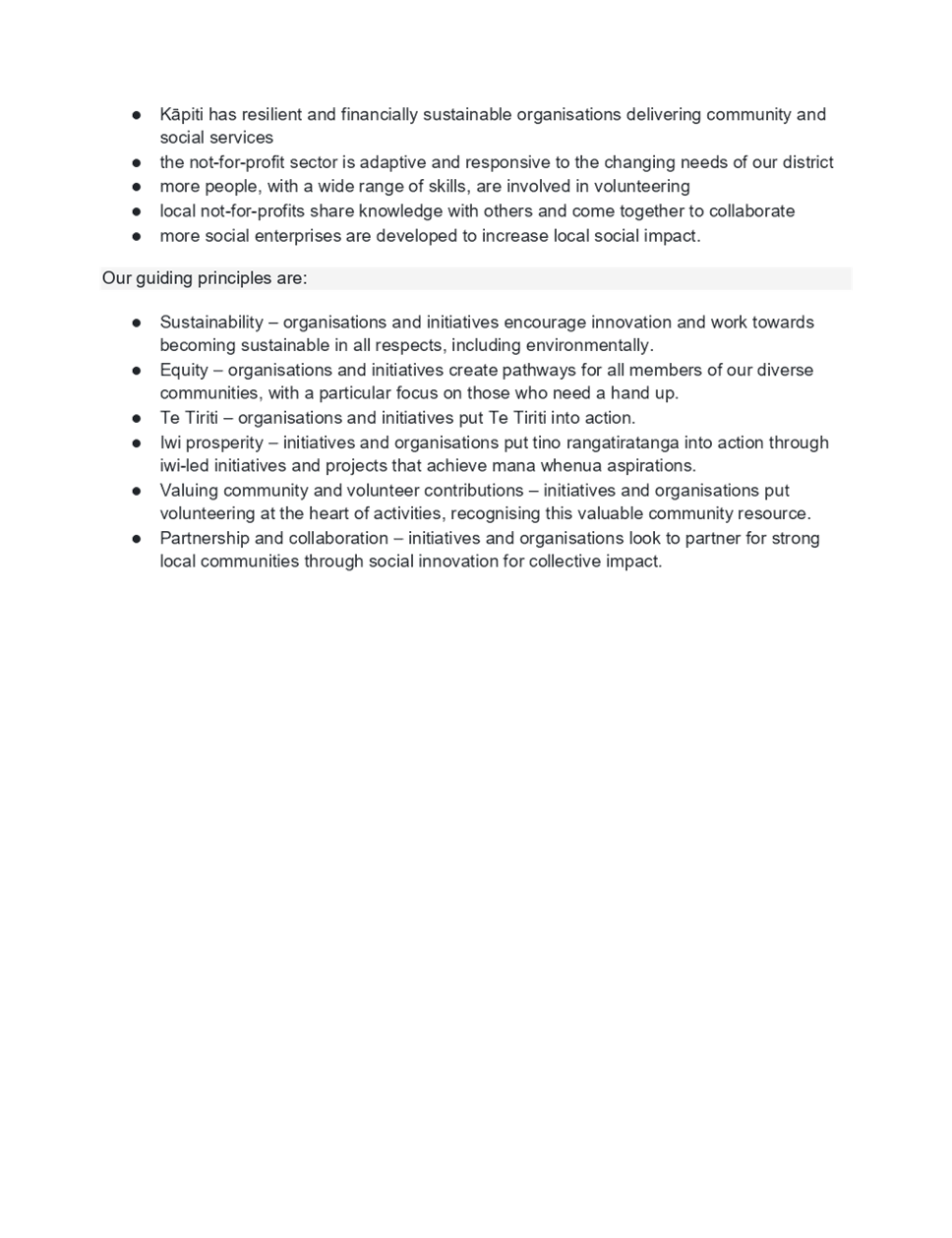
|
Strategy and Operations Committee Meeting
Agenda
|
9 June 2022
|
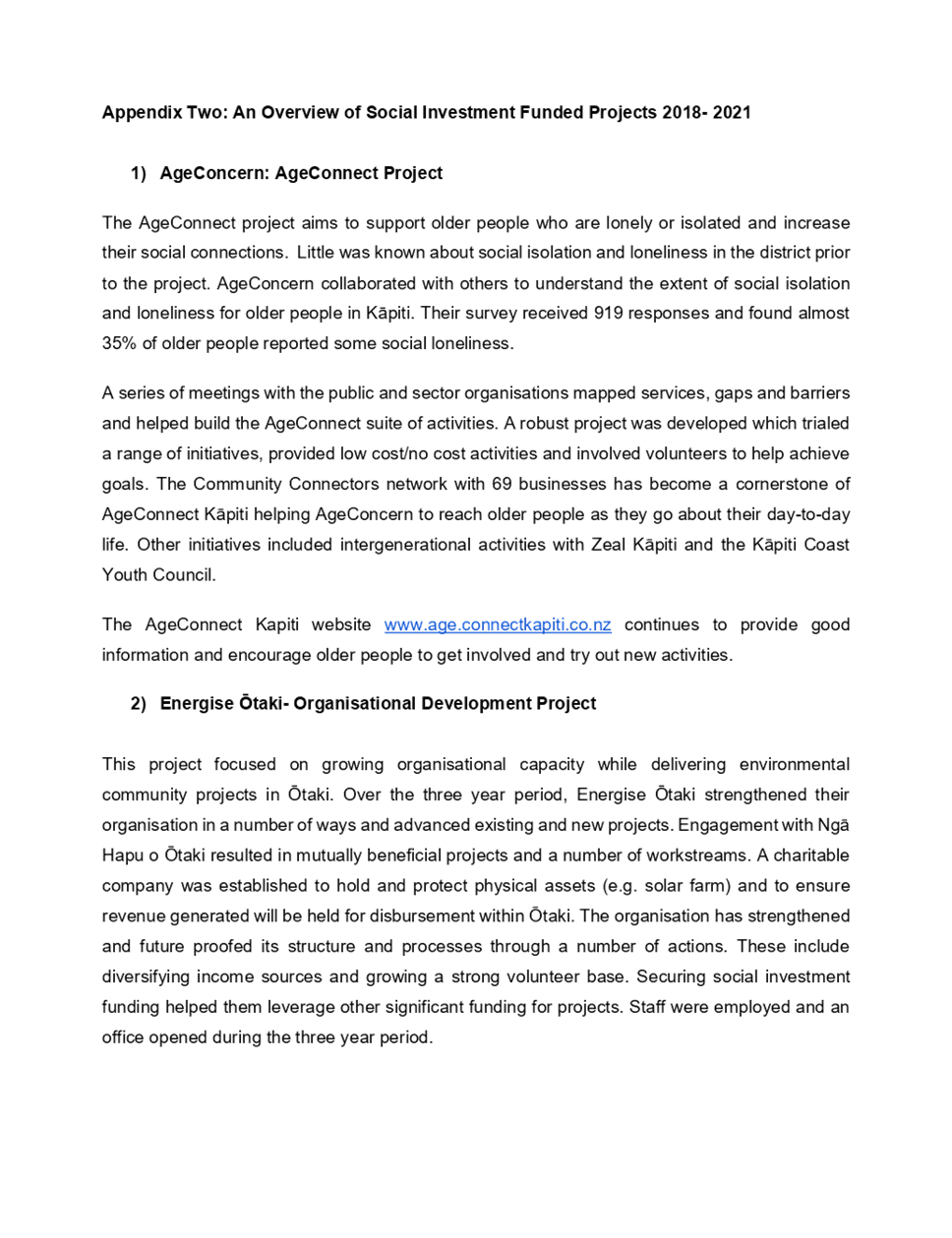
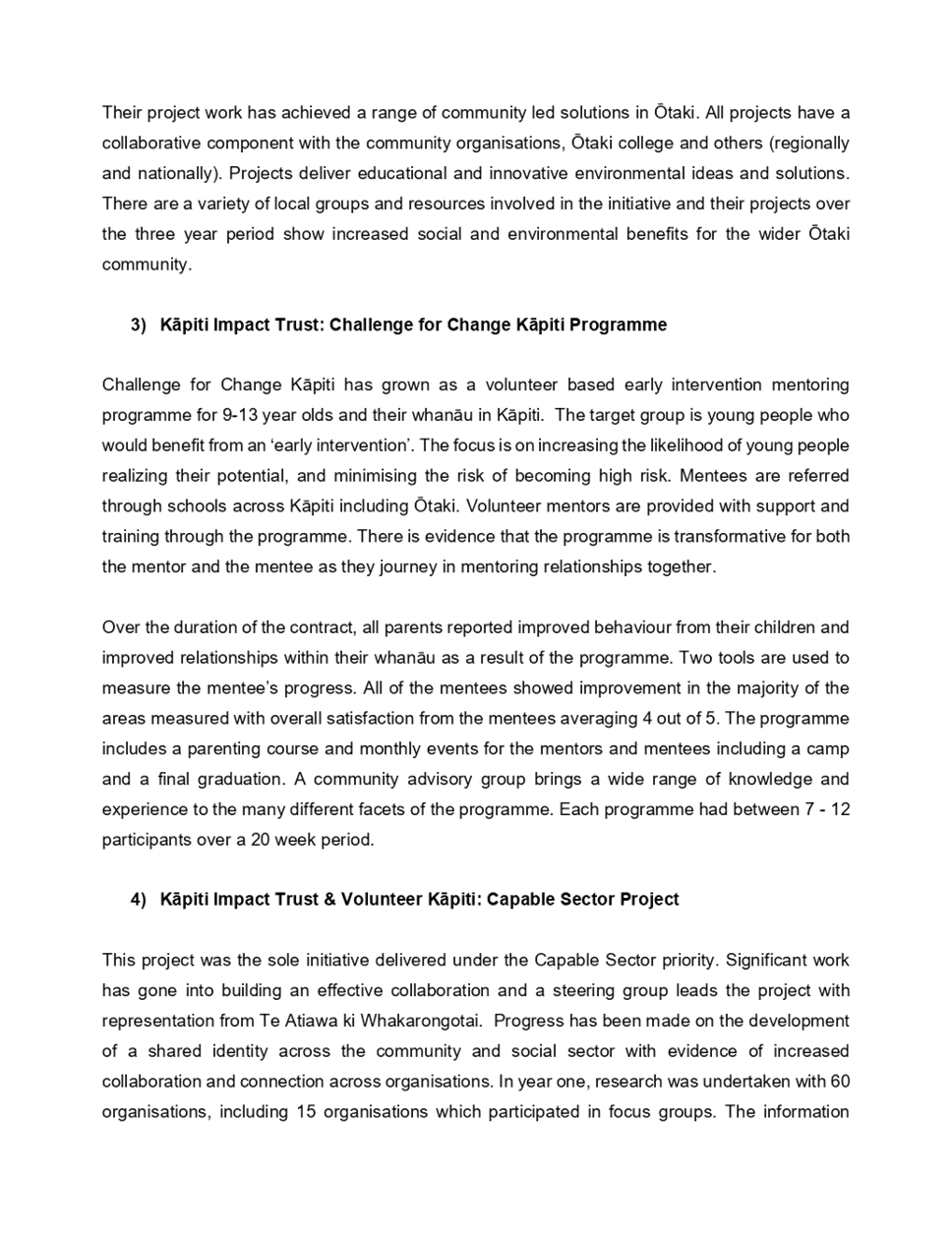
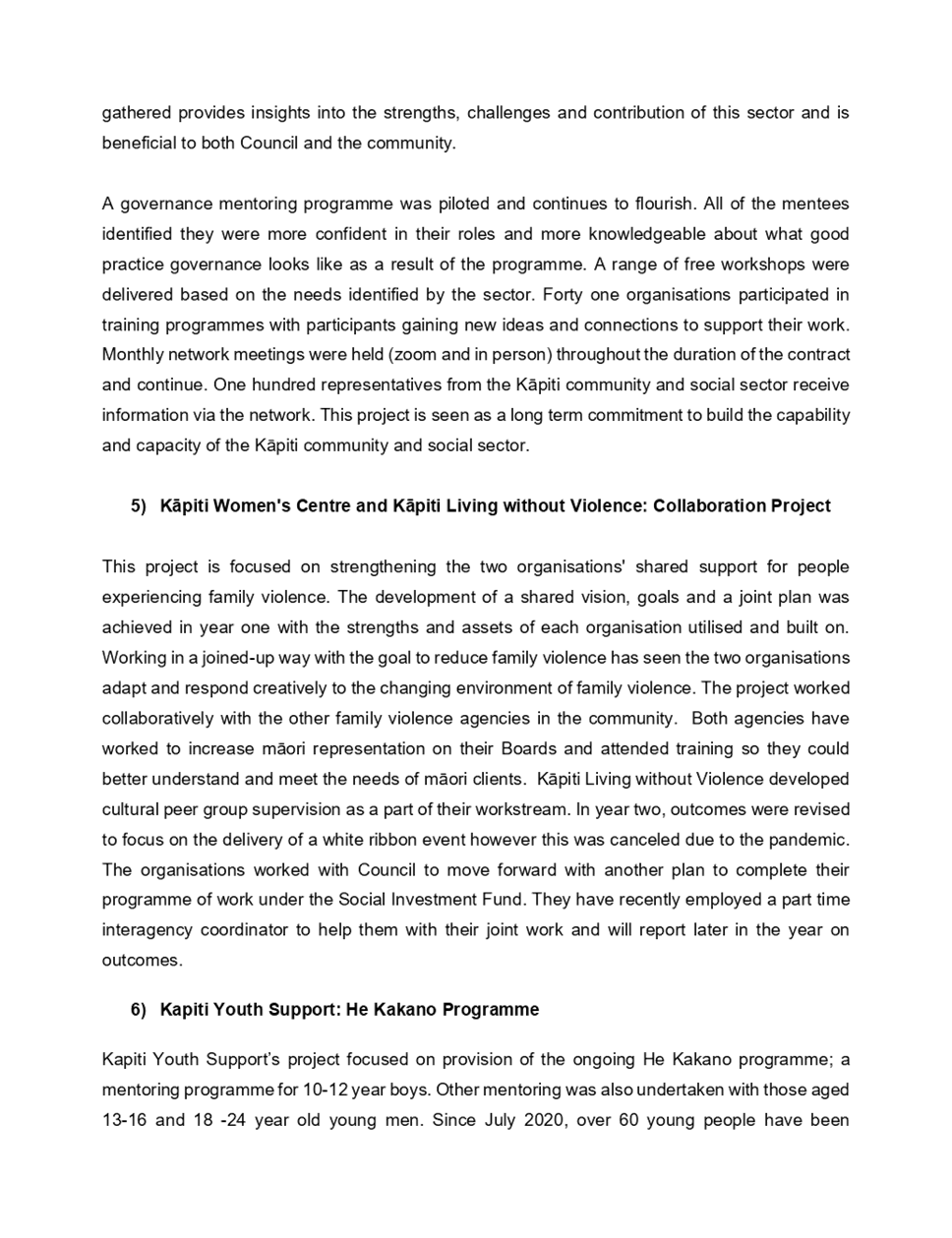
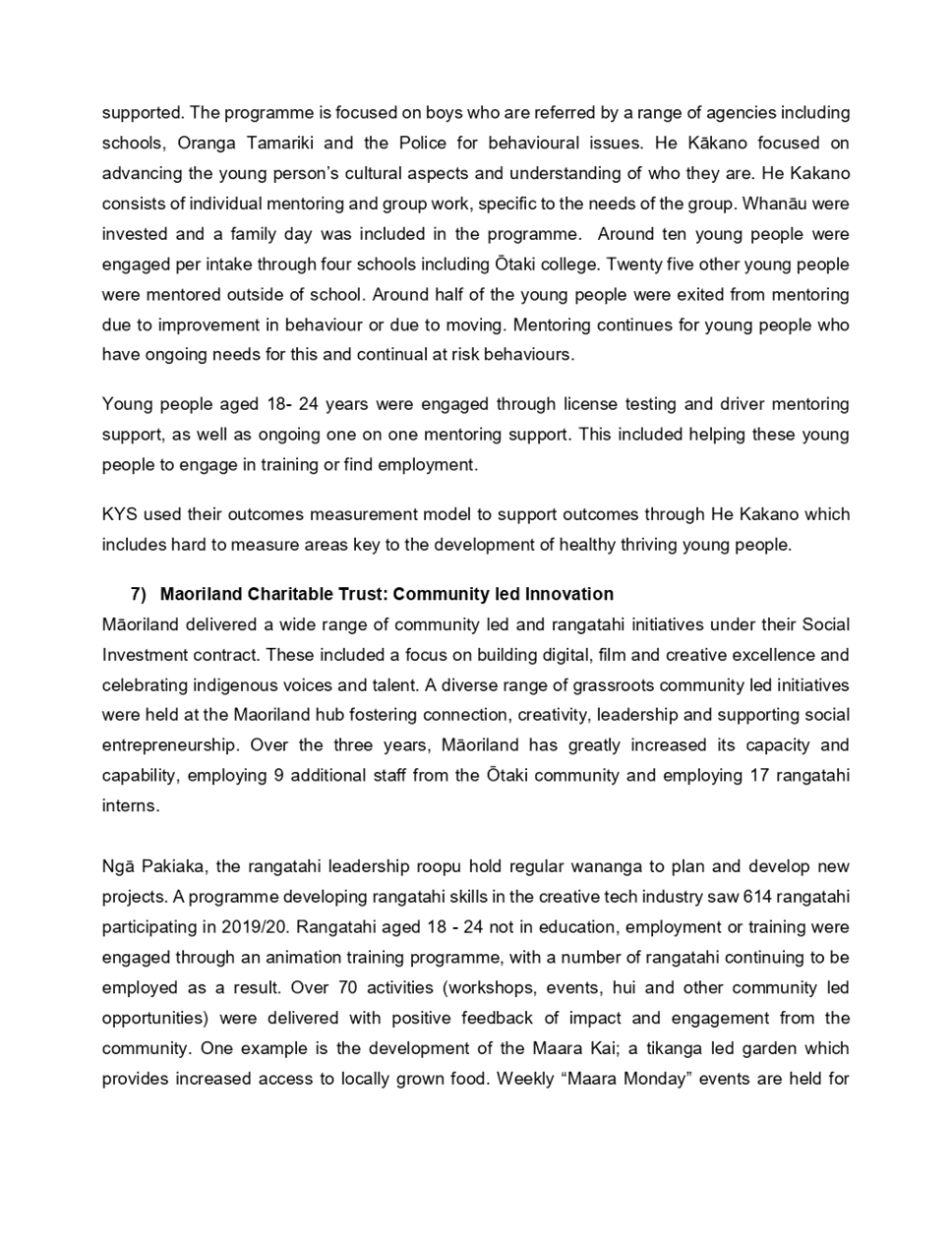
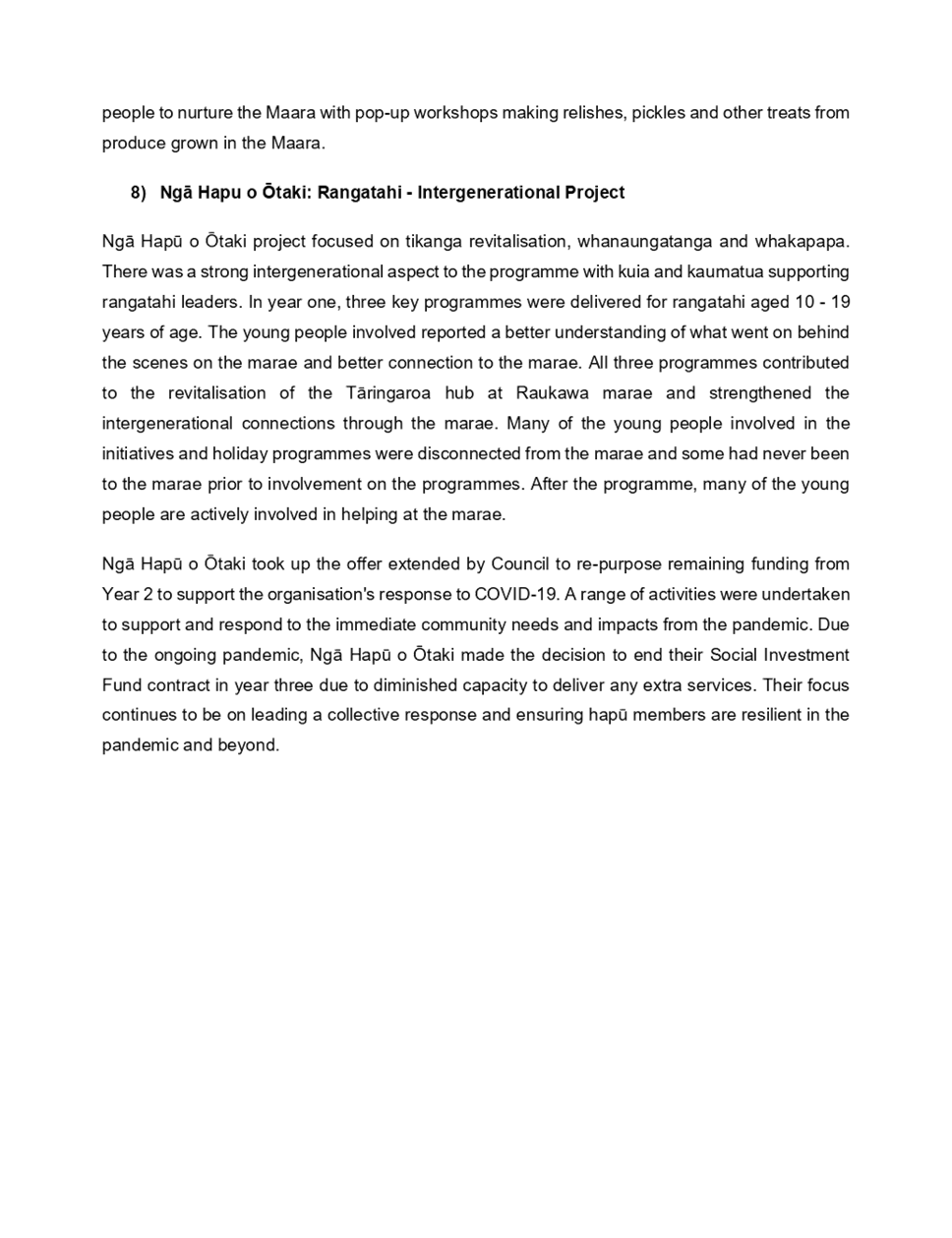
8.5 National
Policy Statement on Urban Development - Quarter 1-3 monitoring reports
Kaituhi |
Author: Hamish
McGillivray, Manager Research & Policy
Kaiwhakamana
| Authoriser: Angela Bell, Strategy Manager
Te pūtake |
Purpose
1 To
provide the Committee with National Policy Statement on Urban Development
(NPS-UD) Monitoring for the first, second and third quarter for the 2021/22
year, covering the period from 1 June 2021 to 28 February 2022).
2 Monitoring
reports for first and second quarter (combined) and third quarter, are included
as Attachment 1 and 2 of this report.
He
whakarāpopoto | Executive summary
3 The
attached reports provide an update and key findings from monitoring of recent
development activity and urban development indicators over the 1 June 2021 to
28 February 2022 period.
Te tuku haepapa
| Delegation
4 The
Strategy and Operations Committee has the authority to consider this matter
under section B.1 of the Governance structure and delegations 2019-2022.
Taunakitanga | RECOMMENDATIONS
A. That
the Committee receives and notes the findings of the NPS-UD monitoring reports
for Quarter 1 and 2 (combined) and Quarter 3, as attached as Attachments 1 and
2 of this report.
Tūāpapa | Background
5 The
NPS-UD requires Council to undertake quarterly monitoring across its local
development activity, including a range of market indicators published by the
Ministry of Housing and Urban Development (HUD) as part of their Urban
Dashboard.
6 Monitoring
reports provide information of activity and changes to inform a range of
participants, including Councils own development tools and instruments as well
as local development community and other community and housing.
7 Council
currently publishes results quarterly, typically in September (Q1), December
(Q2), March (Q3), and June (Q4) each year, and focus on changes to key
indicators across the quarters. The September report also contains annual
reporting to provide more in-depth analysis across the previous year.
8 A
focus on progressing Council’s growth strategy and Housing and Business
Assessment (Housing update) has delayed the publication of the results for the
Quarter 1-3 period.
9 Previous
Monitoring Reports are available on our ‘Urban development
capacity’ webpage at
https://www.kapiticoast.govt.nz/our-district/the-kapiti-coast/urban-development-capacity/.
He
kōrerorero | Discussion
10 Appendix
1 includes two monitoring reports. The first includes the Quarter 1 and 2
results for the period 1 June – 30 November 2021. The second reports
results for Quarter 3 (1 December 2021 to 28 February 2022).
11 The
Monitoring Reports provide an update and analysis of changes across the housing
and development market for the above periods. Specifically, this focuses on
Kāpiti Coast District Council’s development activity (resource and
building consent data) during the last three quarters and contains updated data
on indicators from HUD’s Dashboard, where available.
12 Key
findings from development activity across the last three quarters include:
|
|
2020/21
|
2021/2022
|
|
|
Quarter 4
|
Quarter 1
|
Quarter 2
|
Quarter 3
|
|
Resource consents granted
|
67
|
59
|
53
|
62
|
|
Net additional dwellings
|
135
|
107
|
448
|
159
|
|
Building consents
|
187
|
184
|
192
|
164
|
|
Building consent value
|
$46,435,987
|
$50,129,841
|
$81,496,612
|
$60,568,187
|
13 Other
key findings of note during the period includes a slowing of house values and
social housing registrations.
|
|
2020/21
|
2021/2022
|
|
|
Quarter 4
|
Quarter 1
|
Quarter 2
|
Quarter 3
|
|
House values
|
$840,000
|
$837,000
|
$830,000
|
$880,000
|
|
|
March 2021
|
June 2021
|
September 2021
|
December 2021
|
|
MSD Housing register
|
180
|
189
|
183
|
198
|
He
take | Issues
14 This
report is for noting findings from NPS-UD monitoring only.
Ngā
kōwhiringa | Options
15 This
report is for noting findings from NPS-UD monitoring only.
Tangata whenua
16 We
have not engaged directly with iwi on this report.
Panonitanga āhuarangi | Climate change
17 This
report does not directly consider climate change matters but provides
information around changes and pressures relating to housing and business
demand that informs processes managing how we grow, which consider the impacts
of climate change and low carbon living.
Ahumoni me ngā rawa | Financial
and resourcing
18 There
are no financial considerations arising from this report.
Ture me ngā Tūraru | Legal
and risk
The
reports attached as Attachments 1 and 2 meet the NPS-UD 2020 requirement to
monitor and publish monitoring results.Ngā
pānga ki ngā kaupapa here |
Policy impact
20 As
well as meeting the requirements of the NPS-UD, monitoring information helps
understand changes across the local housing market and supports implementation
of Te tupu pai – Growing Well - District Growth Strategy and
providing sufficient development capacity to meet current and future housing
and business needs.
Te whakawhiti
kōrero me te tūhono | Communications & engagement
21 The
attached NPS-UD reports will be published alongside previous monitoring reports
on our website (as per paragraph 9).
Te mahere tūhono | Engagement
planning
22 The
reports provide an update to monitoring information and have a low level of
significance under Council’s Significance and Engagement Policy, with no
further engagement planned.
Whakatairanga |
Publicity
23 The
NPS-UD Monitoring Reports will be published on the Council’s ‘Urban
Development’ webpage alongside previous reports. An email will also be
distributed to update a list of stakeholders who have expressed an interest in
the reports and to receive future updates.
Ngā āpitihanga | Attachments
1. NPS-UD
Quarter 1 and 2 Monitoring Report December 2021 ⇩ 
2. NPS-UD
Quarter 3 Monitoring Report March 2022 ⇩ 
|
Strategy and
Operations Committee Meeting Agenda
|
9 June 2022
|
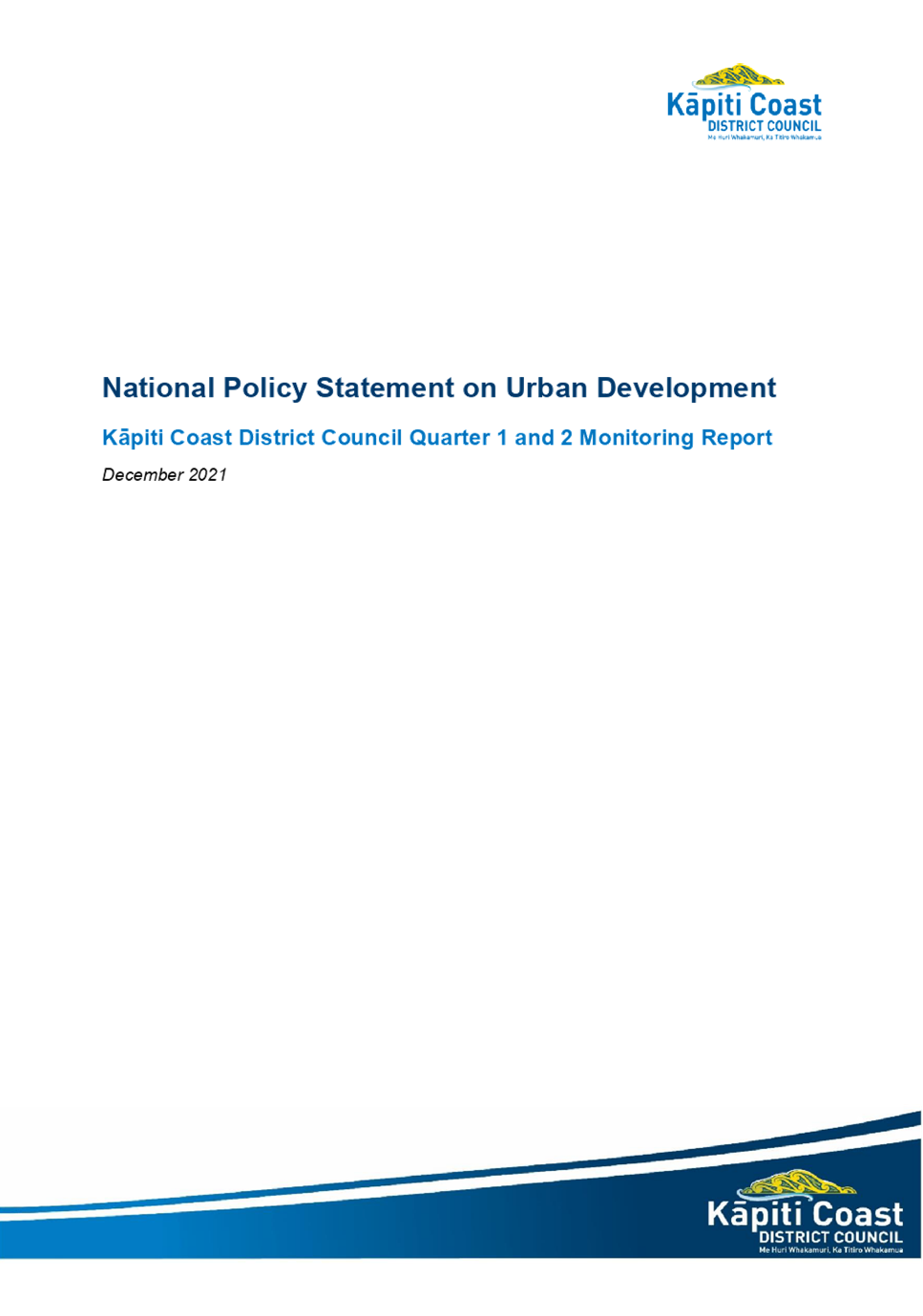
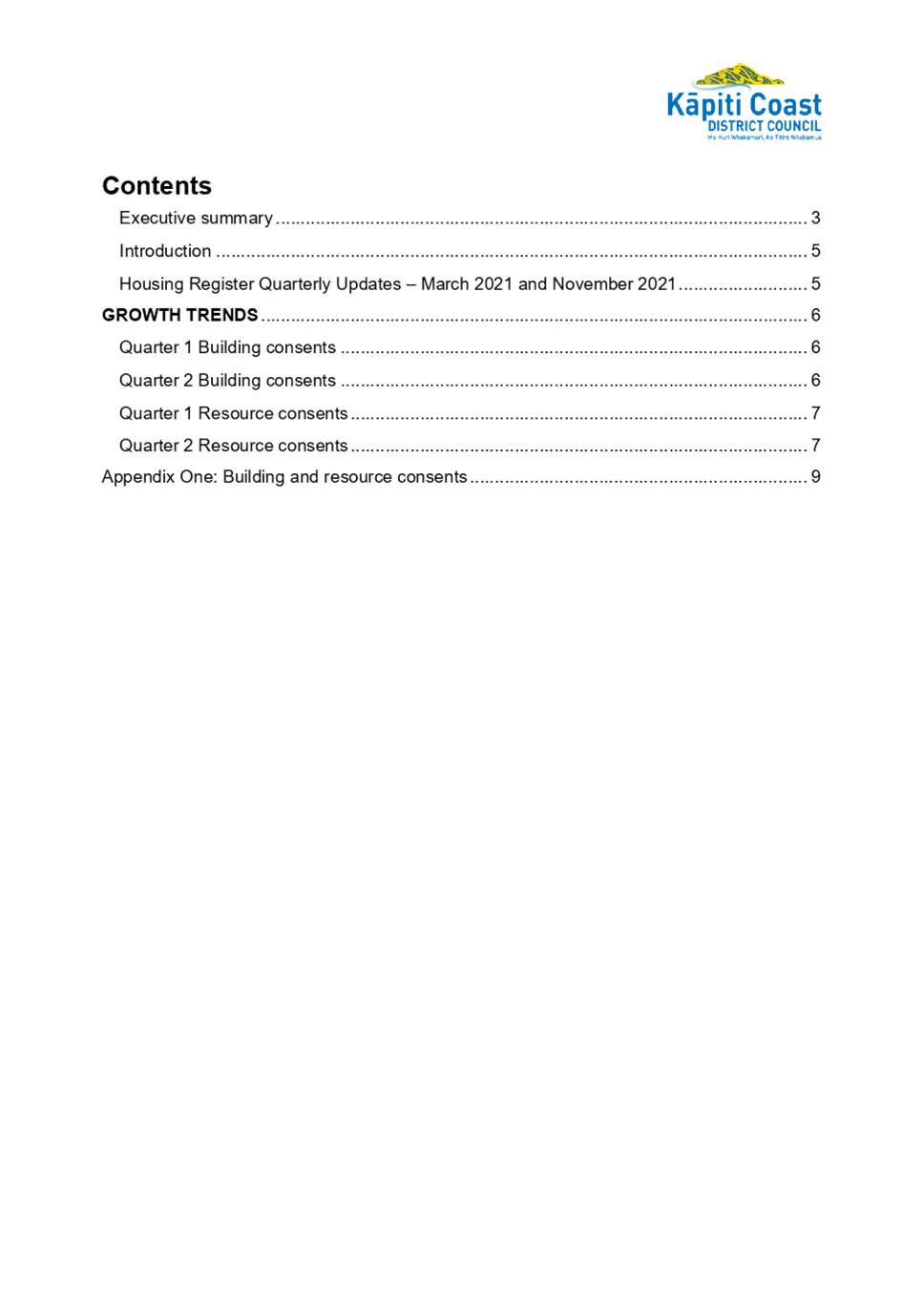
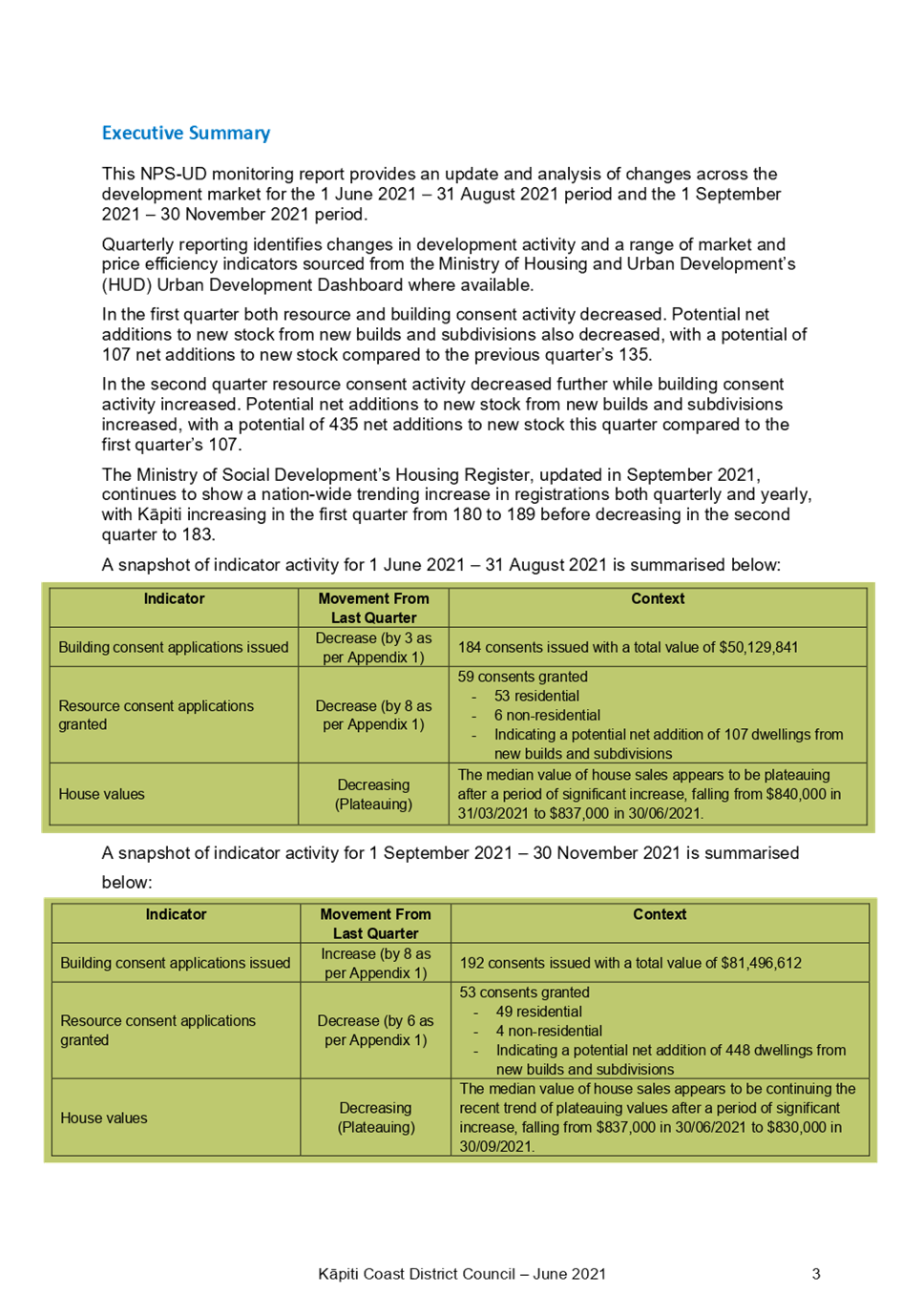

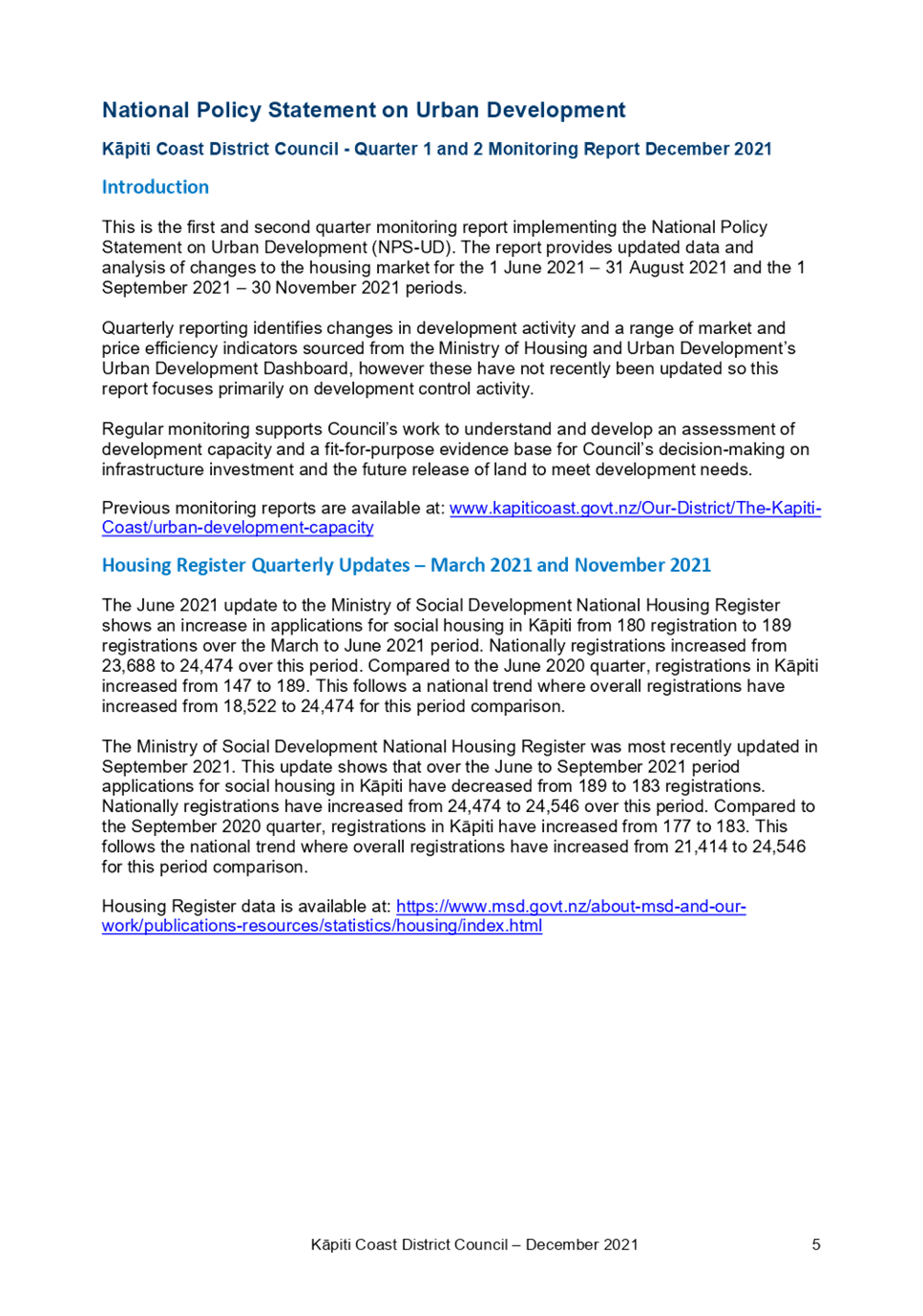
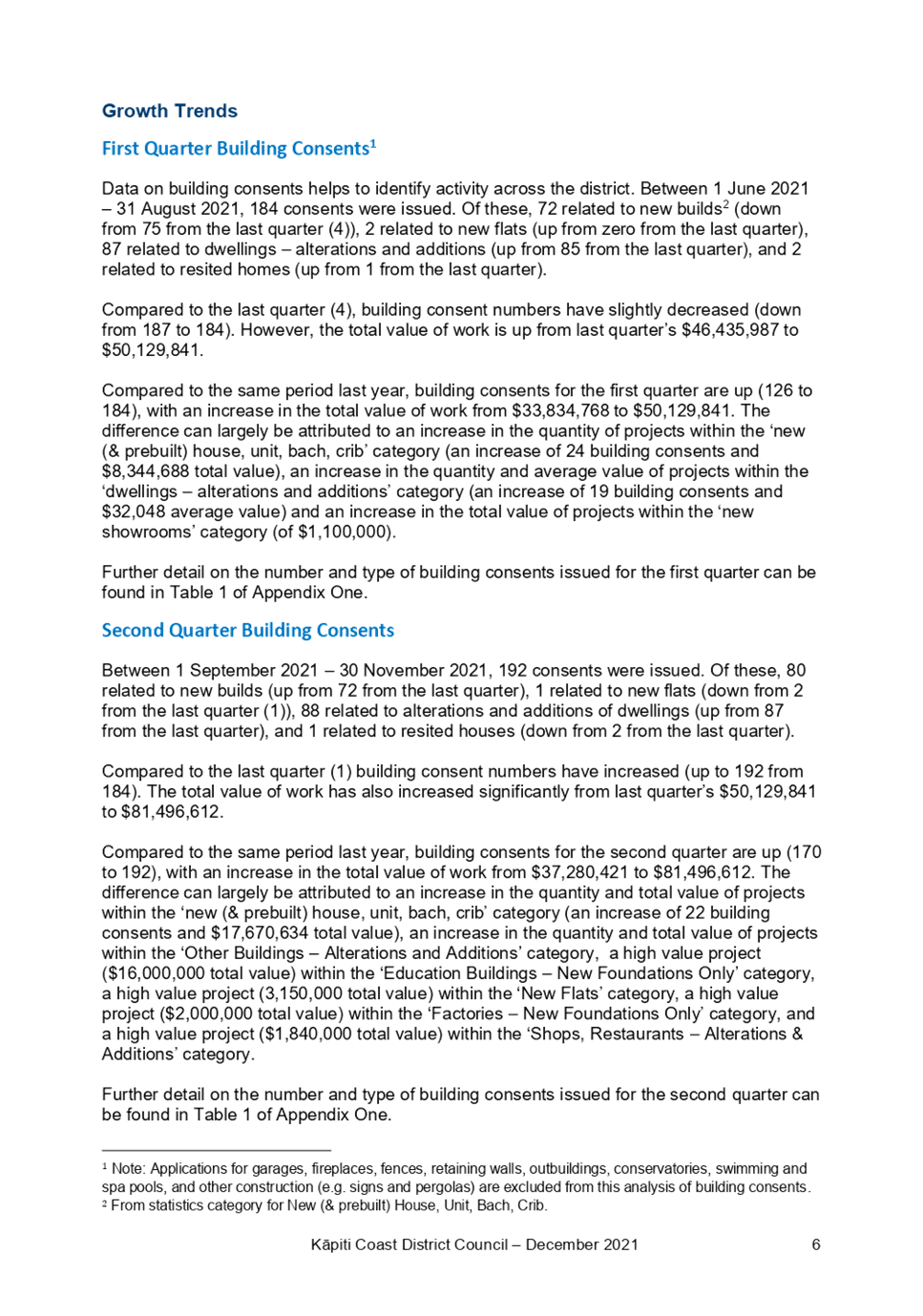
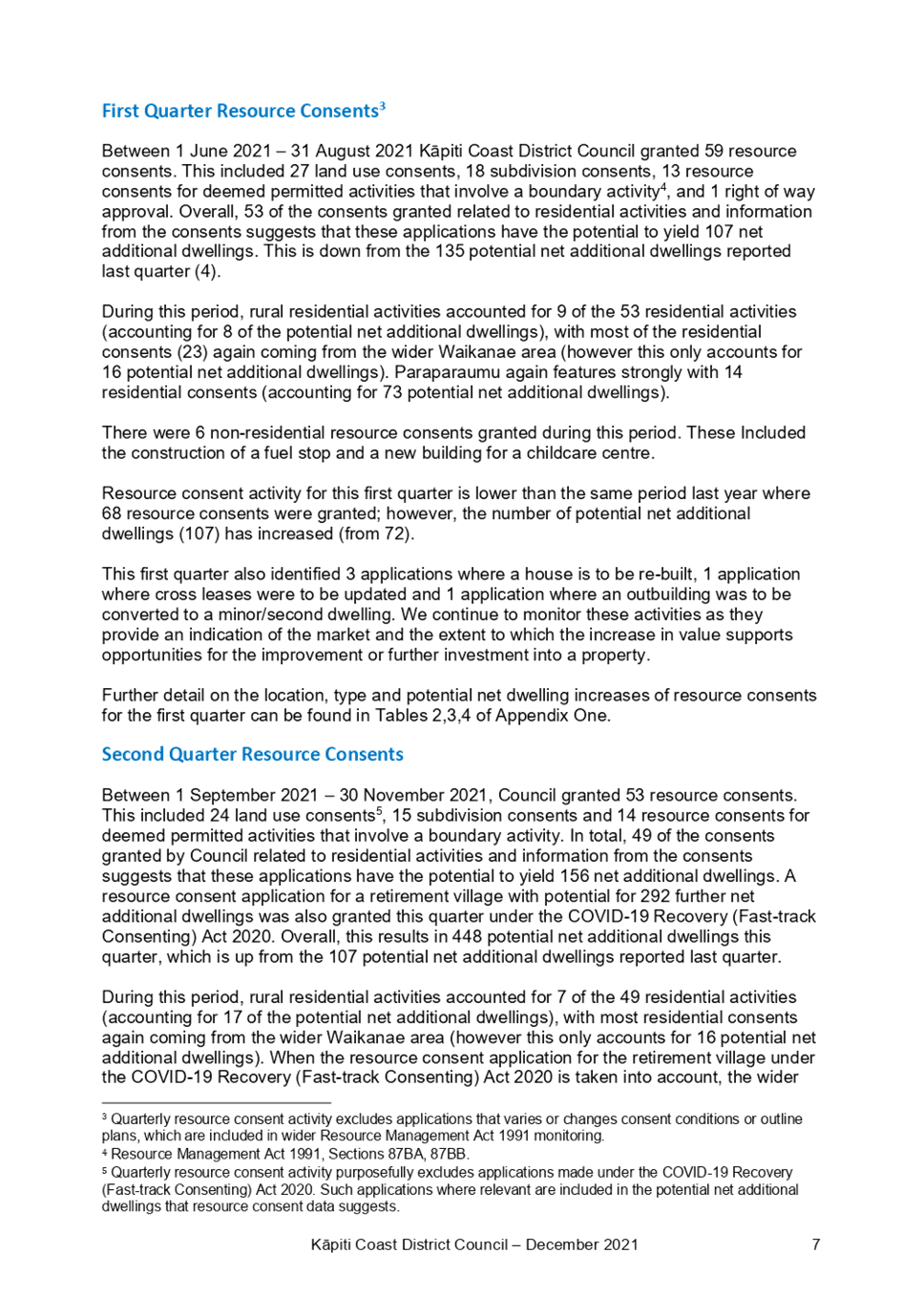



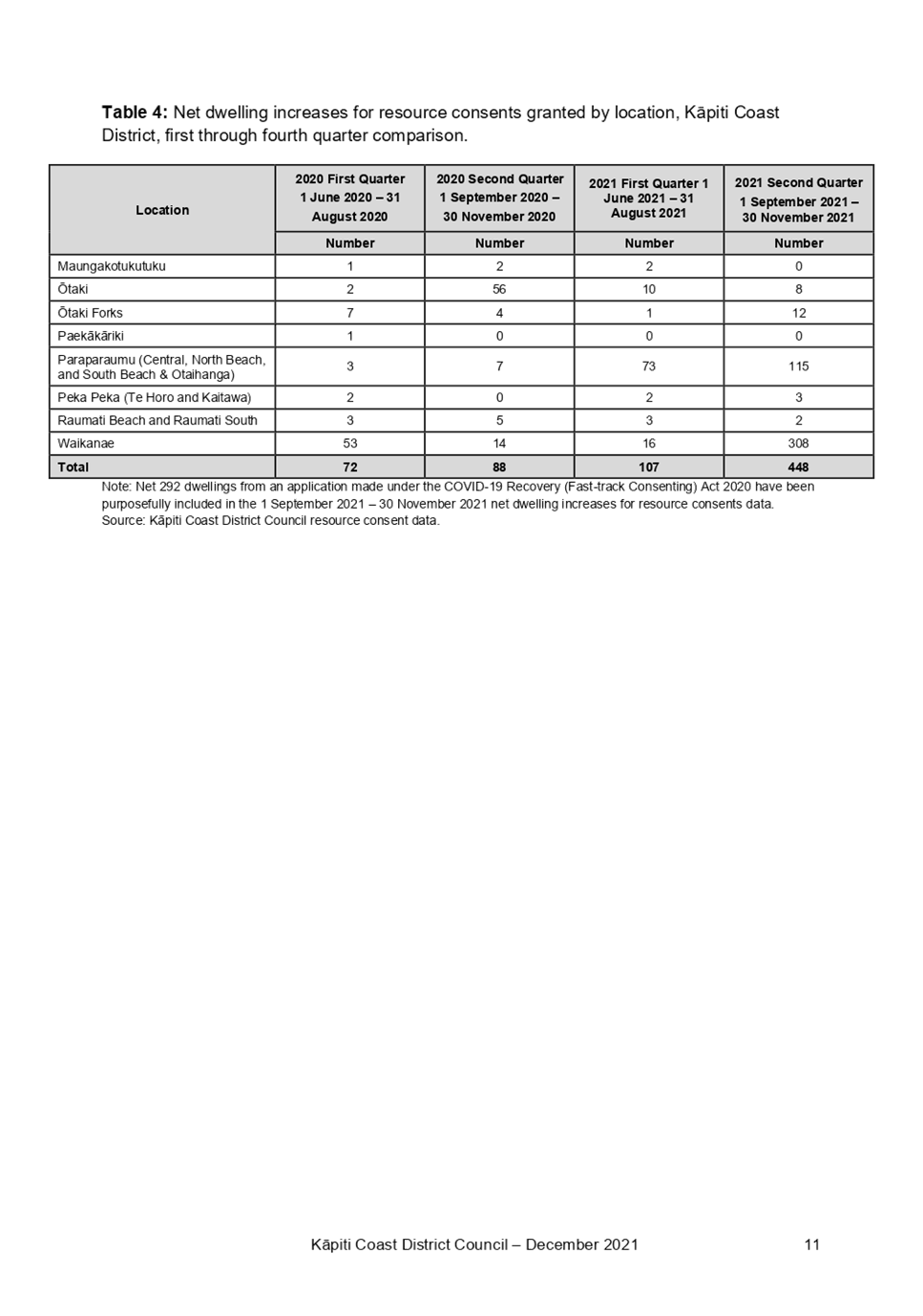
|
Strategy and Operations Committee Meeting
Agenda
|
9 June 2022
|

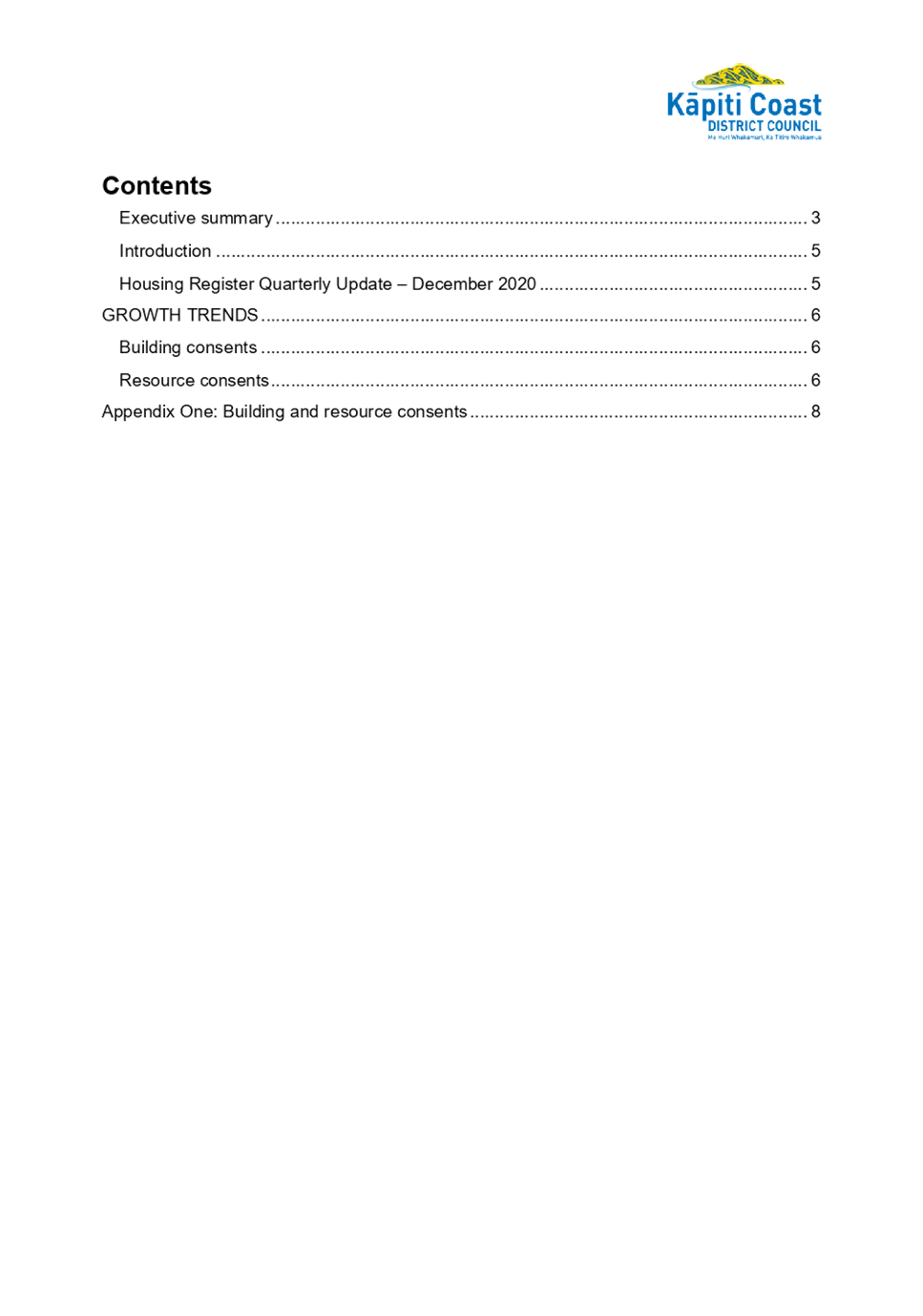

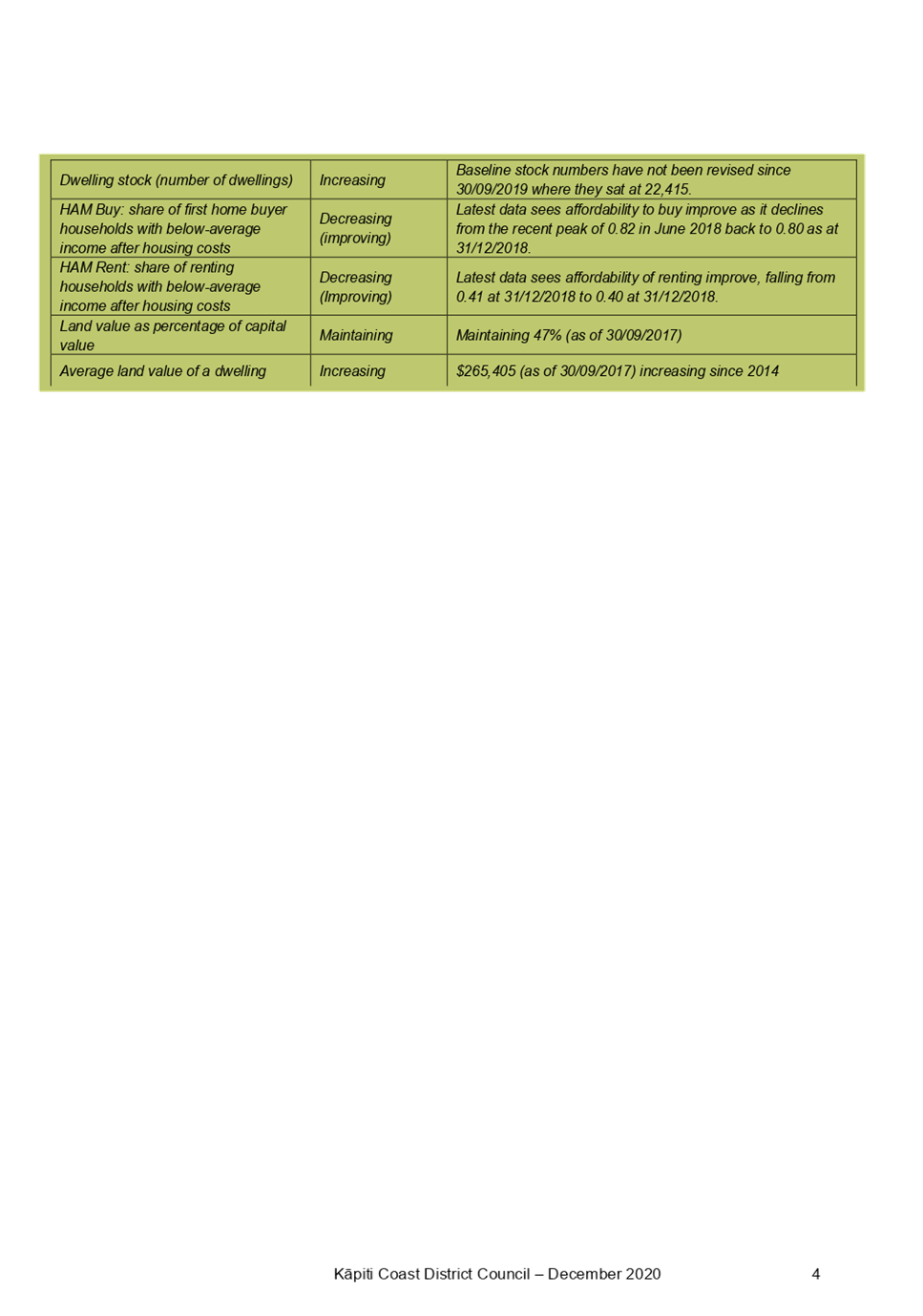
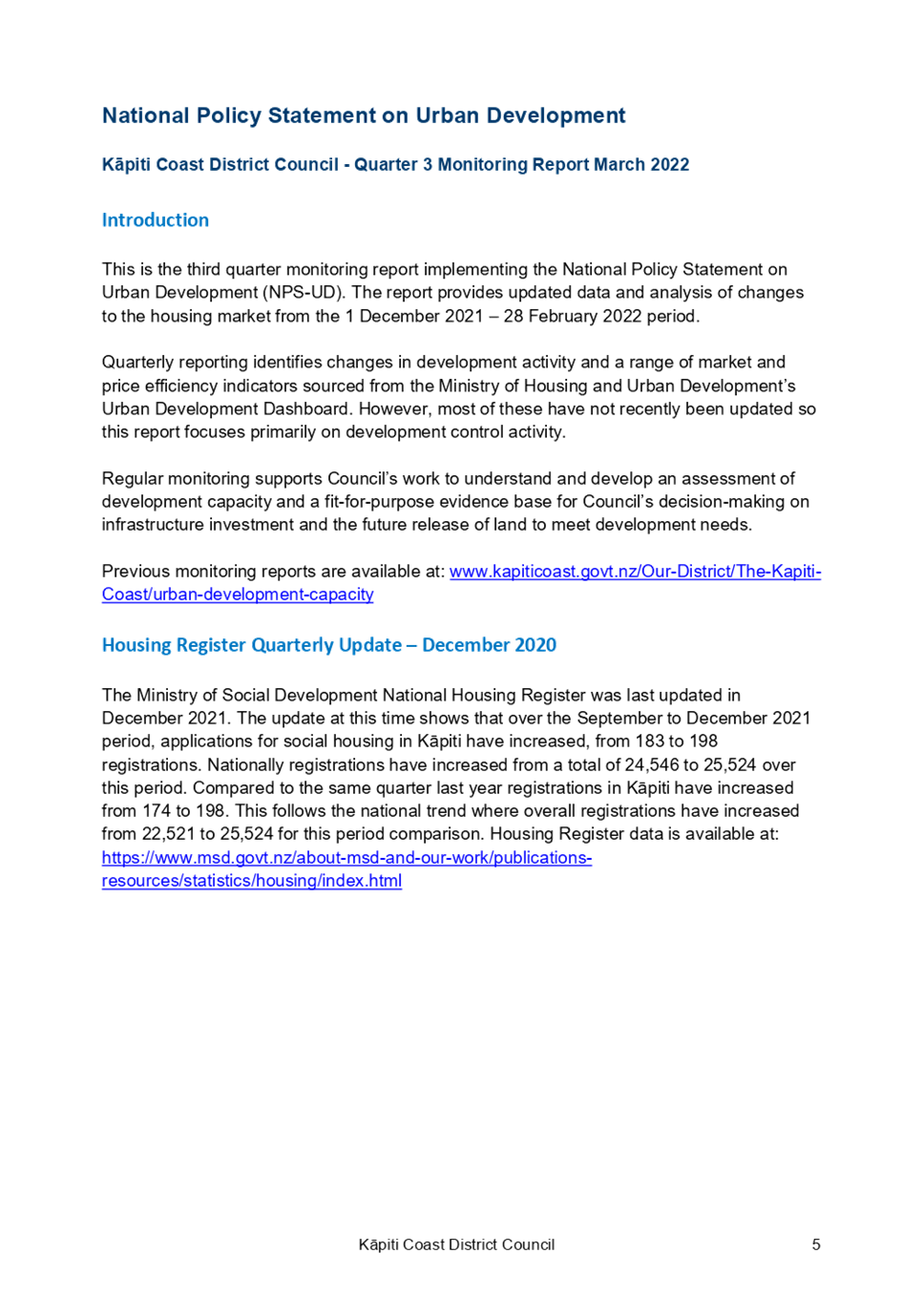
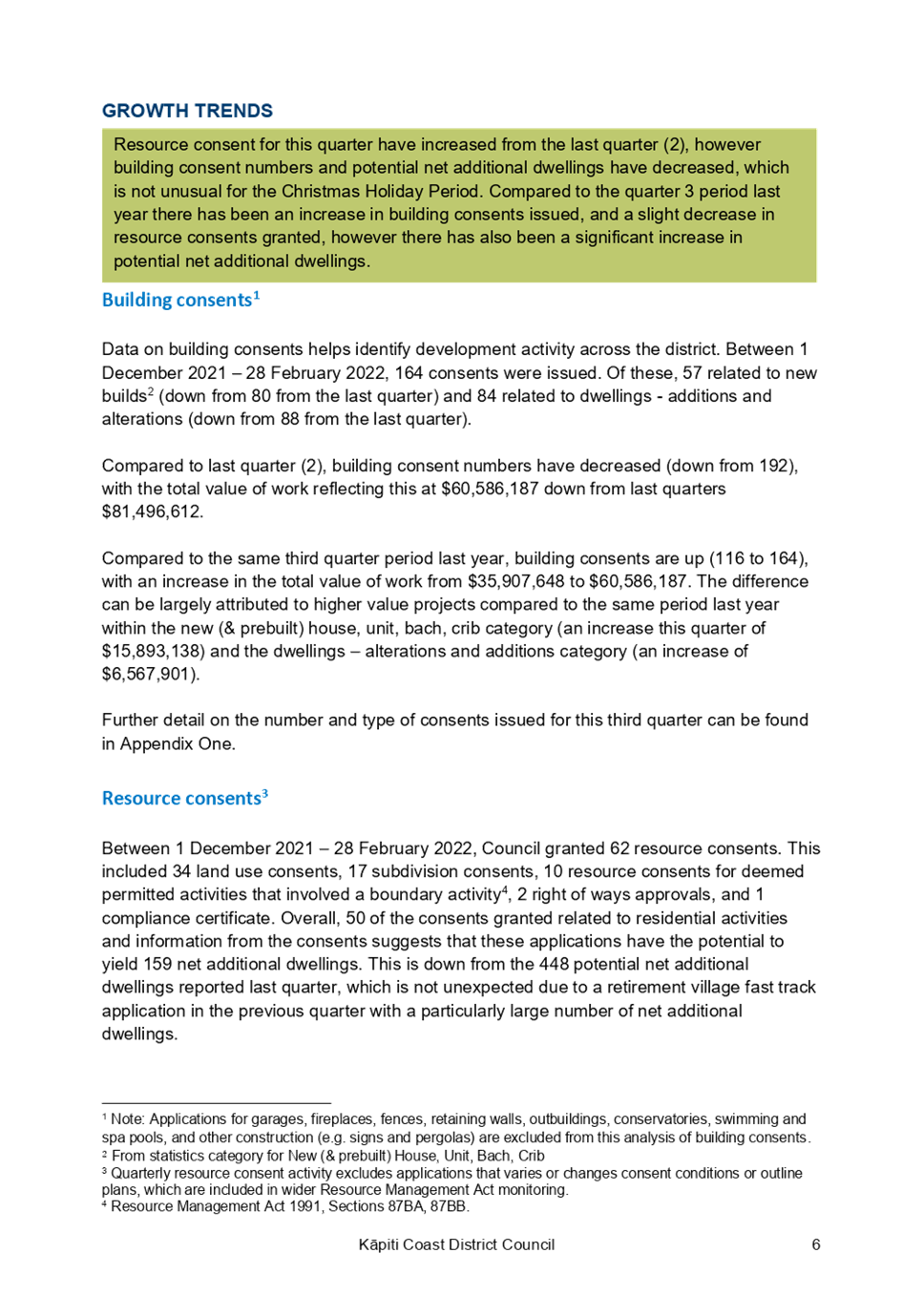




9 Confirmation
of Minutes
9.1 Confirmation
of minutes
Author: Kate
Coutts, Democracy Services Advisor
Authoriser: Janice
McDougall, Group Manager People and Partnerships
|
Taunakitanga |
Recommendations
1. That
the minutes of the Strategy and Operations Committee meeting of 4 November
2021 be accepted as a true and correct record.
2. That
the minutes of the Strategy and Operations Committee meeting of 12 May 2022
be accepted as a true and correct record.
|
Appendices
1. Confirmation
of Minutes - Strategy and Operations Committee 4 November 2021 ⇩ 
2. Confirmation
of Minutes - Strategy and Operations Committee 12 May 2022 ⇩ 
|
Strategy and
Operations Committee Meeting Agenda
|
9 June 2022
|
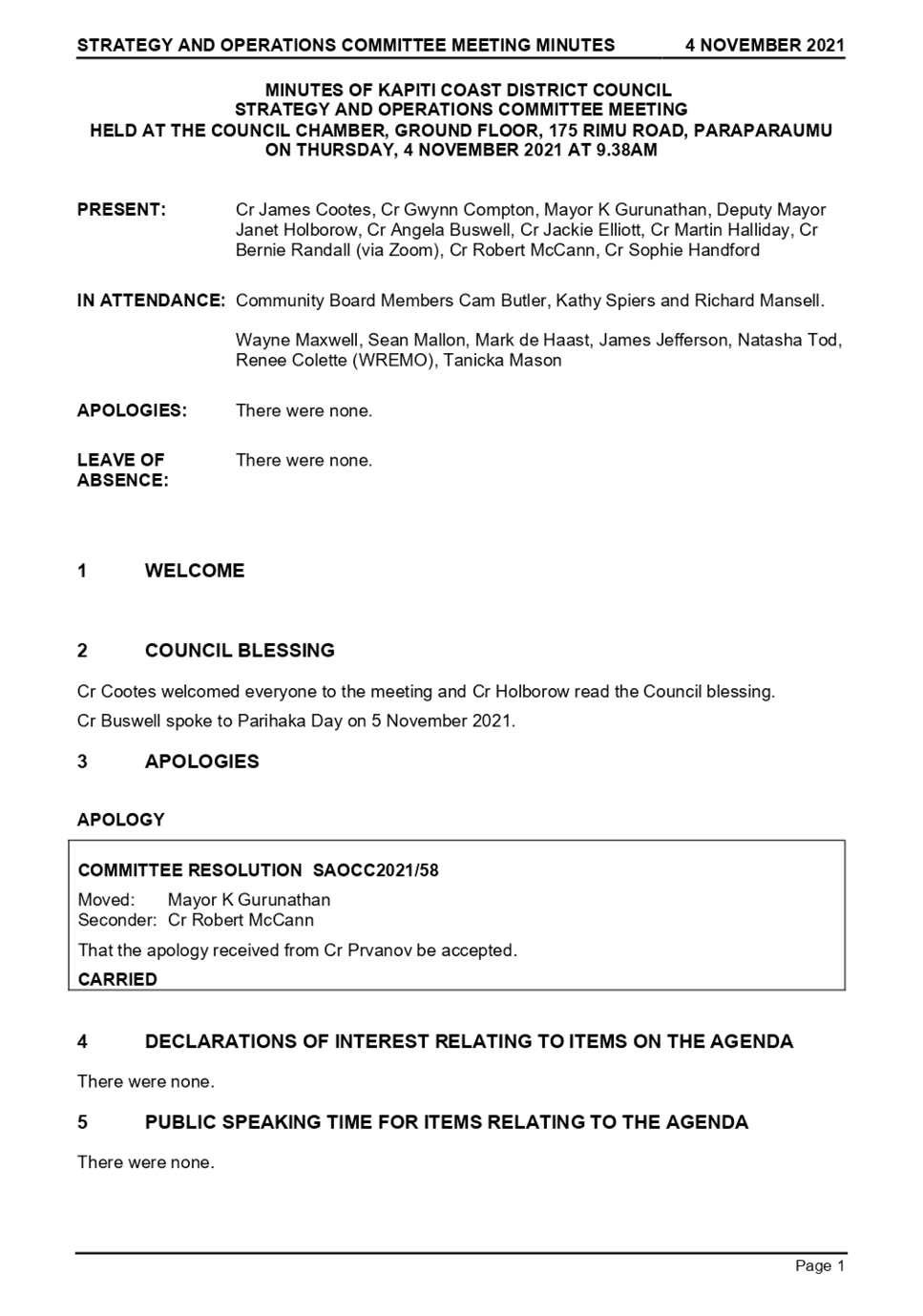

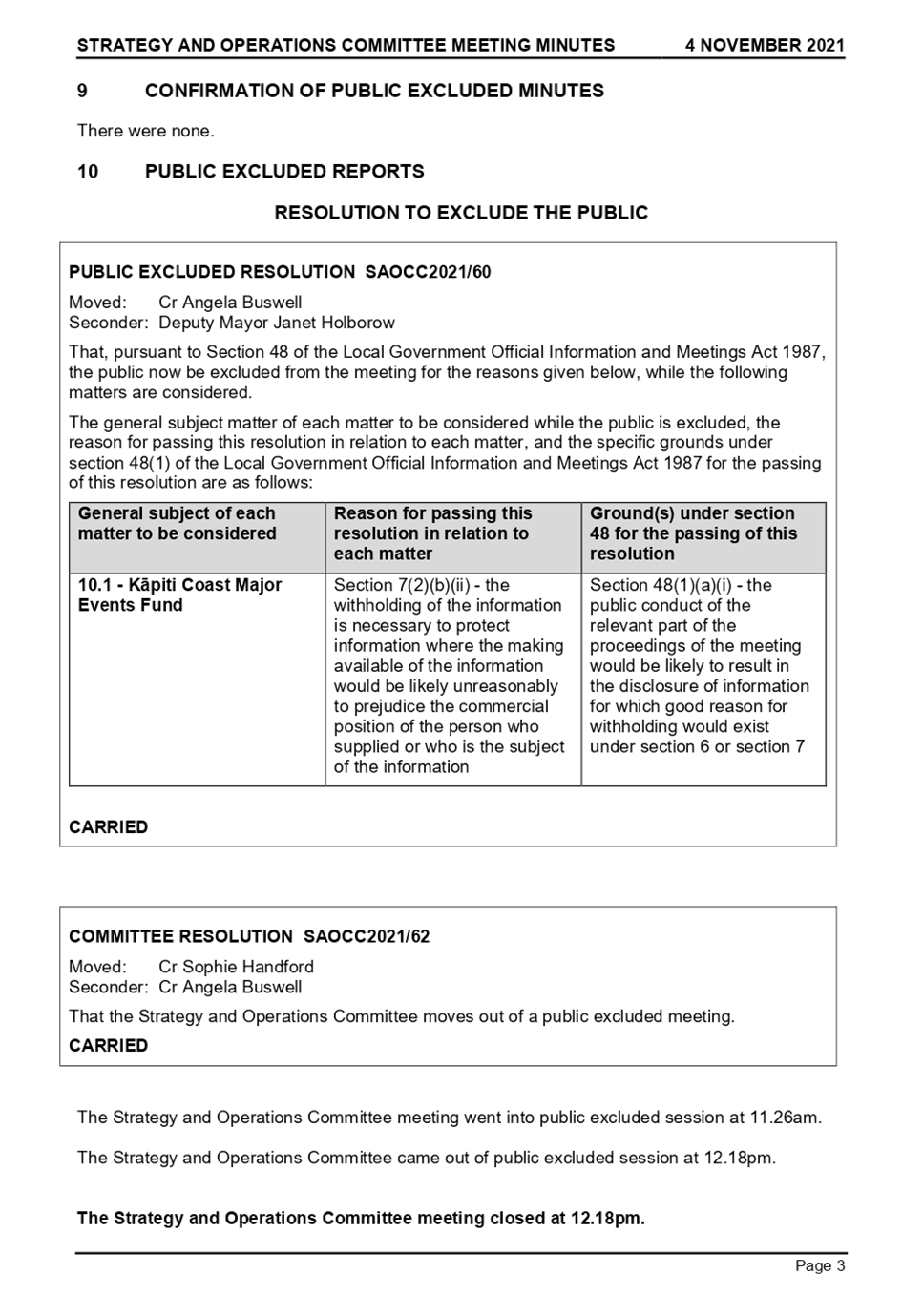

|
Strategy and Operations Committee Meeting
Agenda
|
9 June 2022
|




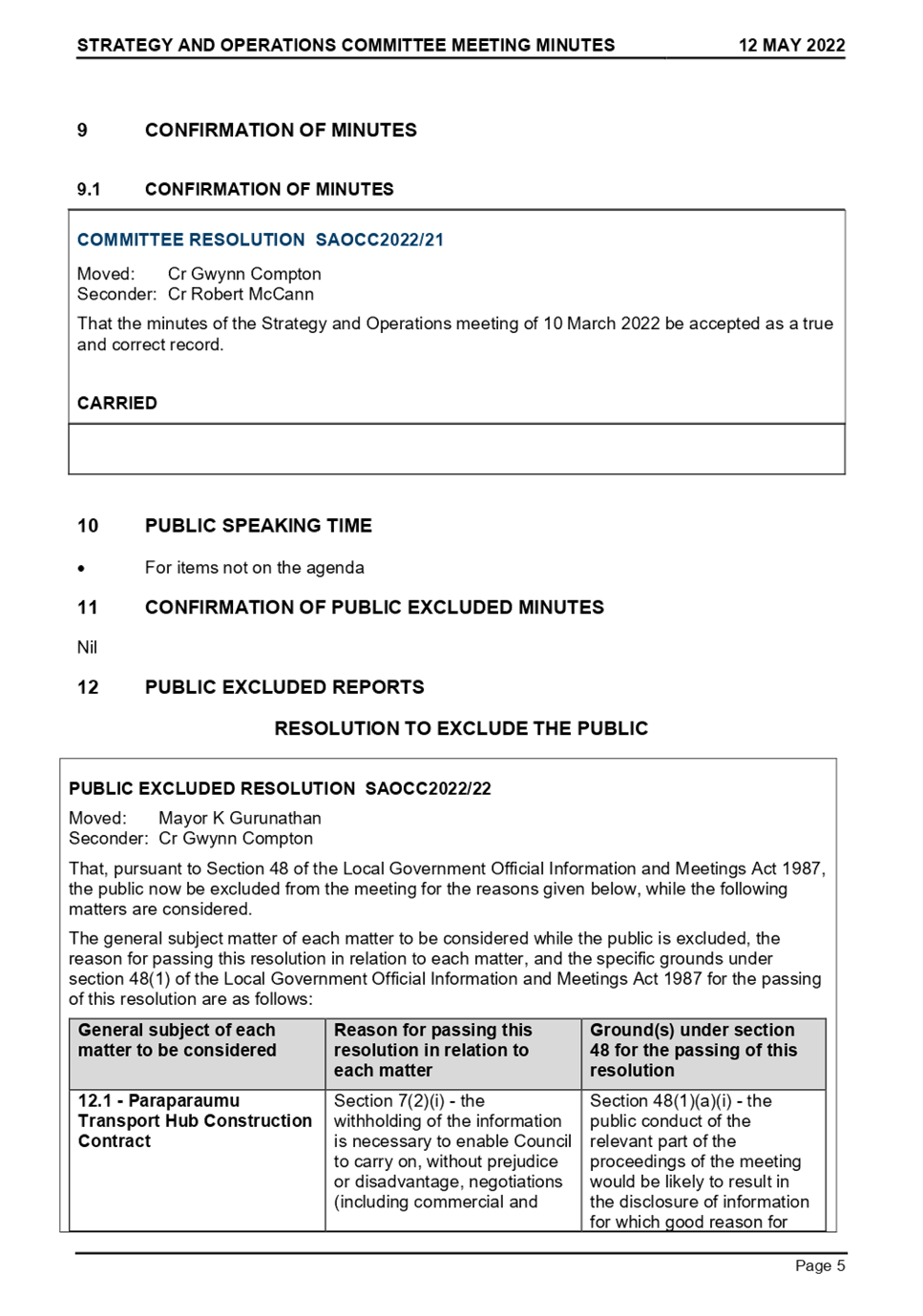

12 Public
Excluded Reports
Resolution
to Exclude the Public
|
PUBLIC EXCLUDED ReSOLUtion
That, pursuant to Section 48 of the Local Government
Official Information and Meetings Act 1987, the public now be excluded from
the meeting for the reasons given below, while the following matters are
considered.
The general subject matter of each matter to be considered
while the public is excluded, the reason for passing this resolution in
relation to each matter, and the specific grounds under section 48(1) of the
Local Government Official Information and Meetings Act 1987 for the passing
of this resolution are as follows:
|
General subject of each
matter to be considered
|
Reason for passing this
resolution in relation to each matter
|
Ground(s) under section 48
for the passing of this resolution
|
|
11.1 - Confirmation of Public Excluded Minutes
|
Section 7(2)(b)(ii) - the withholding of the information
is necessary to protect information where the making available of the
information would be likely unreasonably to prejudice the commercial
position of the person who supplied or who is the subject of the information
Section 7(2)(i) - the withholding of the information is
necessary to enable Council to carry on, without prejudice or disadvantage,
negotiations (including commercial and industrial negotiations)
|
Section 48(1)(a)(i) - the public conduct of the relevant
part of the proceedings of the meeting would be likely to result in the
disclosure of information for which good reason for withholding would exist
under section 6 or section 7
|
|
12.1 - Major Events Fund 2022/23 Closeout and
Recommendations
|
Section 7(2)(a) - the withholding of the information is
necessary to protect the privacy of natural persons, including that of
deceased natural persons
Section 7(2)(b)(ii) - the withholding of the information
is necessary to protect information where the making available of the
information would be likely unreasonably to prejudice the commercial
position of the person who supplied or who is the subject of the
information
|
Section 48(1)(a)(i) - the public conduct of the relevant
part of the proceedings of the meeting would be likely to result in the
disclosure of information for which good reason for withholding would exist
under section 6 or section 7
|
|





























































































































































































